
Airport profile: Keflavík
Special report: ASQ Winners
Plus:
IN THE SPOTLIGHT: MASTER PLANNING & DESIGN
Volume 29 – Issue 2, 2024



aci.aero
New Product
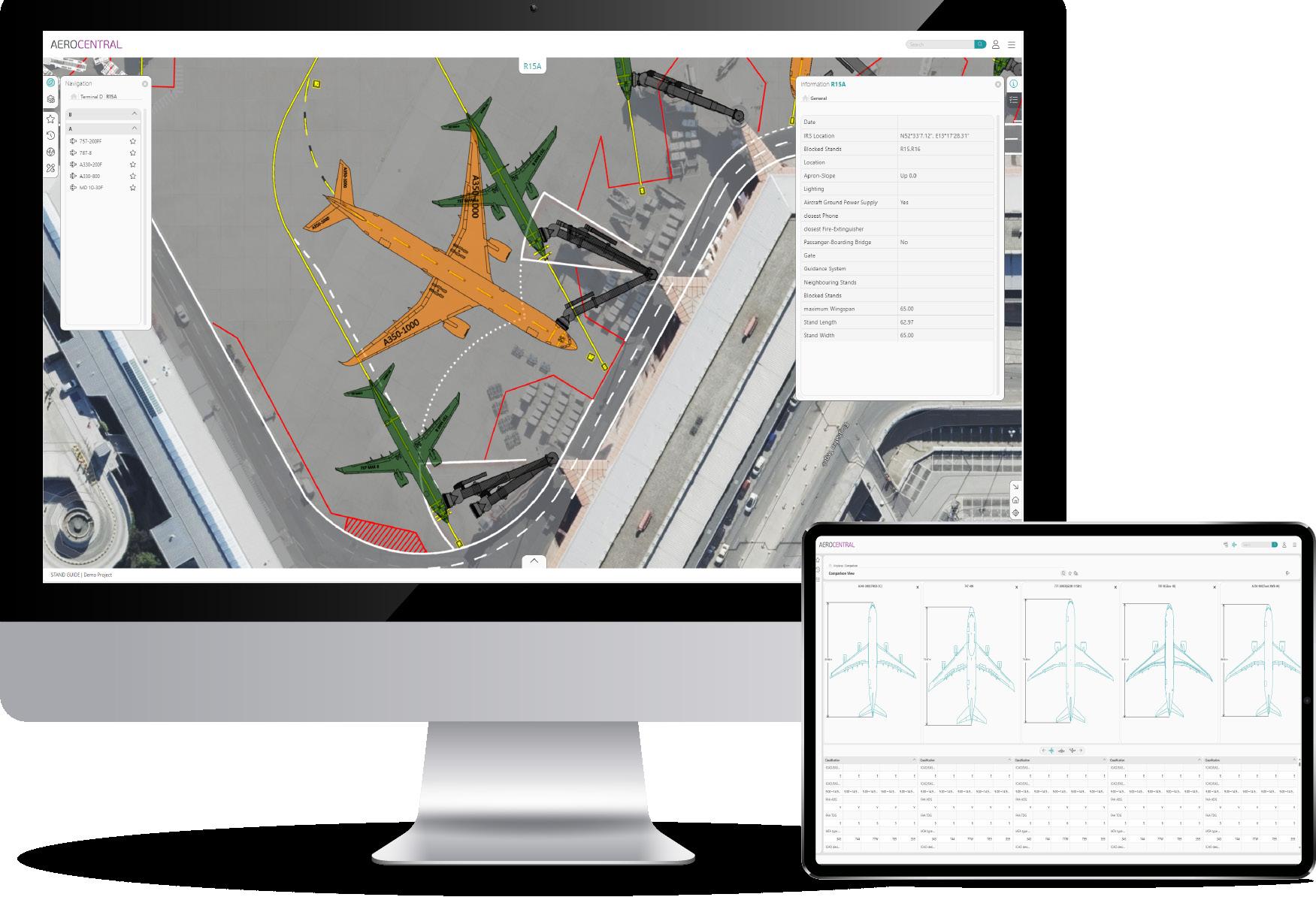
BRIDGING THE GAP BETWEEN AIRPORT PLANNING AND OPERATIONS
Streamline collaboration, reduce uncertainty, and enhance the safety and efficiency of airside operations.
Discover how the new cloud-based platform, AeroCENTRAL, will simplify how you share key airside infrastructure and operational information.
To learn more, scan the QR code or visit transoftsolutions.com
Airport World
Editor
Joe Bates +44 (0)1276 476582 joe@airport-world.com
Sales Directors
Jonathan Lee +44 (0)208 707 2743 jonathan@airport-world.com
Jon Sissons +44 (0)208 707 2743 jon.sissons@airport-world.com
Advertising Manager
Andrew Hazell +44 (0)208 384 0206 andrewh@airport-world.com
Design, Layout & Production
Mark Draper +44 (0)208 707 2743 mark@airport-world.com
Subscriptions
subscriptions@aviationmedia.aero
Managing Director
Jonathan Lee +44 (0)208 707 2743 jonathan@aviationmedia.aero
Worth the wait
Editor, Joe Bates, reflects on the development of key aviation infrastructure in this ‘master planning & design’ themed issue of Airport World.
With so much at stake for local communities, economies and the environment, getting planning mission to build new runways and terminals at existing airports has always been a long and complicated process.
When I first started out as a journalist in the early 1980s, it was generally accepted by airports that it would take a least a decade for them to get approval for a new runway, and considerbly longer for a new passenger terminal, concourse or satellite pier.
There are, after all, environmental concerns to address, hearts and minds to be won in neighbouring communities, airlines to convince that the new facilities are the best way forward for them, and, of course, the small question of finding the funds to pay for the new infrastructure.

article on page 9 of this issue, the importance of prioritising sustainability in airport planning cannot be underestimated.
Indeed, in today’s more environmentally conscious world where images of global climate change can be seen across the planet on an almost weekly basis – the unprecented rainfall and flooding in Dubai and Oman being the most recent examples as we went to press – it is arguably imperative that all new airport facilities are sustainably built, managed and operated.
As you would expect, we cover a significant number of airport development projects from across the globe in the ‘master planning & design’ themed section of AirportWorld.
Published by Aviation Media Ltd PO BOX 448, Feltham, TW13 9EA, UK
Website www.airport-world.com
AirportWorld is published six times a year for the members of ACI World. The opinions and views expressed in AirportWorld are those of the authors and do not necessarily reflect an ACI World policy or position.
ISSN: 1360-4341
The content of this publication is copyright of Aviation Media Ltd and should not be copied or stored without the express permission of the publisher.
I have been lucky enough to experience and witness, at first hand, many incredible new facilities and greenfield aiports being built over the years, including Terminal’s 2, 4 and 5 at London Heathrow, Budapest’s Sky Court and Toronto Pearson’s Terminal 1 as well as the new airports in Athens, Oslo and Incheon, where at the latter I was actually on site during its construction.
With regards to Heathrow’s Terminal 5, the planning approval process took eight years from first application to government approval, and involved a public inquiry which began on May 16, 1995, and ended on March 17, 1999. It sat for a total of 525 days, cost £80 million and heard something like 700 witnesses.
The long and costly public inquiry – at the time the longest planning inquiry ever held in the UK – delayed the opening of the terminal until March 2008, 15 years after the then owners BAA submitted a formal planning application for its construction.
It might have taken longer than Heathrow wanted, but at least Terminal 5 happened, which is more than can be said for many projects that never make it past the drawing board for a whole host of reasons.
As ACI World director general, Luis Felipe de Oliveira, reiterates in his ‘view from the top’
The features include a review of projects that are either planned, underway or have recently been completed at 12 airports in the US, Colombia, Italy, India, Kuwait, Vietnam and Saudi Arabia.
Elsewhere in the themed section we find out more about the sense of place strategy behind the transformation of Manchester Airport’s retail offering; the role HOK and Arup are playing in the ongoing upgade of LAX; and how rising traffic demand is driving development at US airports.
Our main airport feature shines the spotlight on Keflavík Airport and CEO, Sveinbjörn Indridason, who tells us more about the growth and development of Iceland’s gateway to the world.
Elsewhere in the issue we turn the spotlight on airports that have been recognised for their customer experience excellence in ACI’s Airport Service Quality (ASQ) Awards; discuss the benefits of democratising data; and highlight some of the latest airport sustainability initiatives.
The importance of paying more attention to designing people centric working environments takes centre stage in our regular ‘people matters’ column; and we also report on the latest news from ACI and ACI's World Business Partners (WBP).
I hope you enjoy the issue and look forward to seeing you in Riyadh in May for the ACI Asia-Pacific & Middle East/ACI World Annual General Assembly, Conference and Exhibition in Riyadh.
3 AIRPORT WORLD/ISSUE 2, 2024 AW
OPINION
21 - 23 May 2024
Riyadh, Saudi Arabia







ISSUE 2
Volume 29

In this issue
3 Opinion
Editor, Joe Bates, reflects on the development of key aviation infrastructure in this ‘master planning & design’ themed issue of Airport World
9 View from the top
ACI World director general, Luis Felipe de Oliveira, considers the importance of prioritising sustainability in airport planning.
10 ACI news
The world's busiest airports in 2023, Airport Service Quality (ASQ) customer experience excellence, and a call for greater funding to help Europe’s airports decarbonise.
14 Lean, green and ambitious
Isavia CEO, Sveinbjörn Indridason, tells Joe Bates more about the growth and development plans of Iceland’s Keflavík International Airport.
18 Design and build
Joe Bates considers the infrastructure development challenges facing airports and reviews 12 different projects that are either planned, underway or have been recently completed across the globe.
30 On the menu
32
CONTENTS 5
Michael Murphy-Pyle, head of media at Manchester Airport, tells us more about the sense of place strategy behind the transformation of the gateway’s retail offerings.
All systems go! With traffic levels hitting new highs, an ever increasing number of US airports are investing in new infrastructure and technology to avoid a potential capacity crunch in the near future, writes Mary Scott Nabers.
Volume 29 Issue 2, 2024 Airport profile: Special report: ASQ Winners Democratising Data, aci.aero IN THE SPOTLIGHT: MASTER PLANNING & DESIGN
CONTENTS AIRPORT WORLD/ISSUE 2, 2024

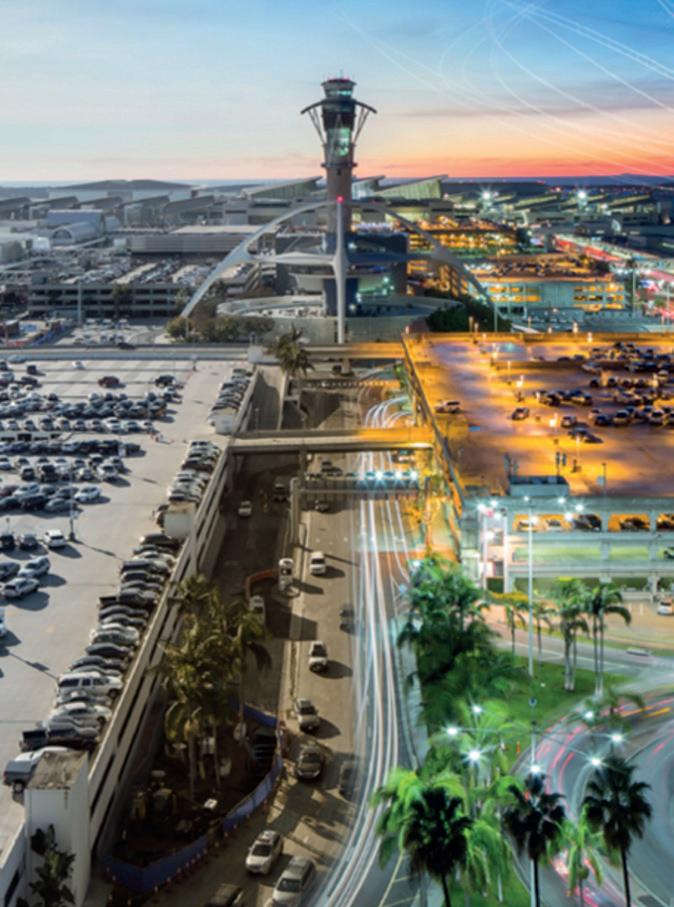
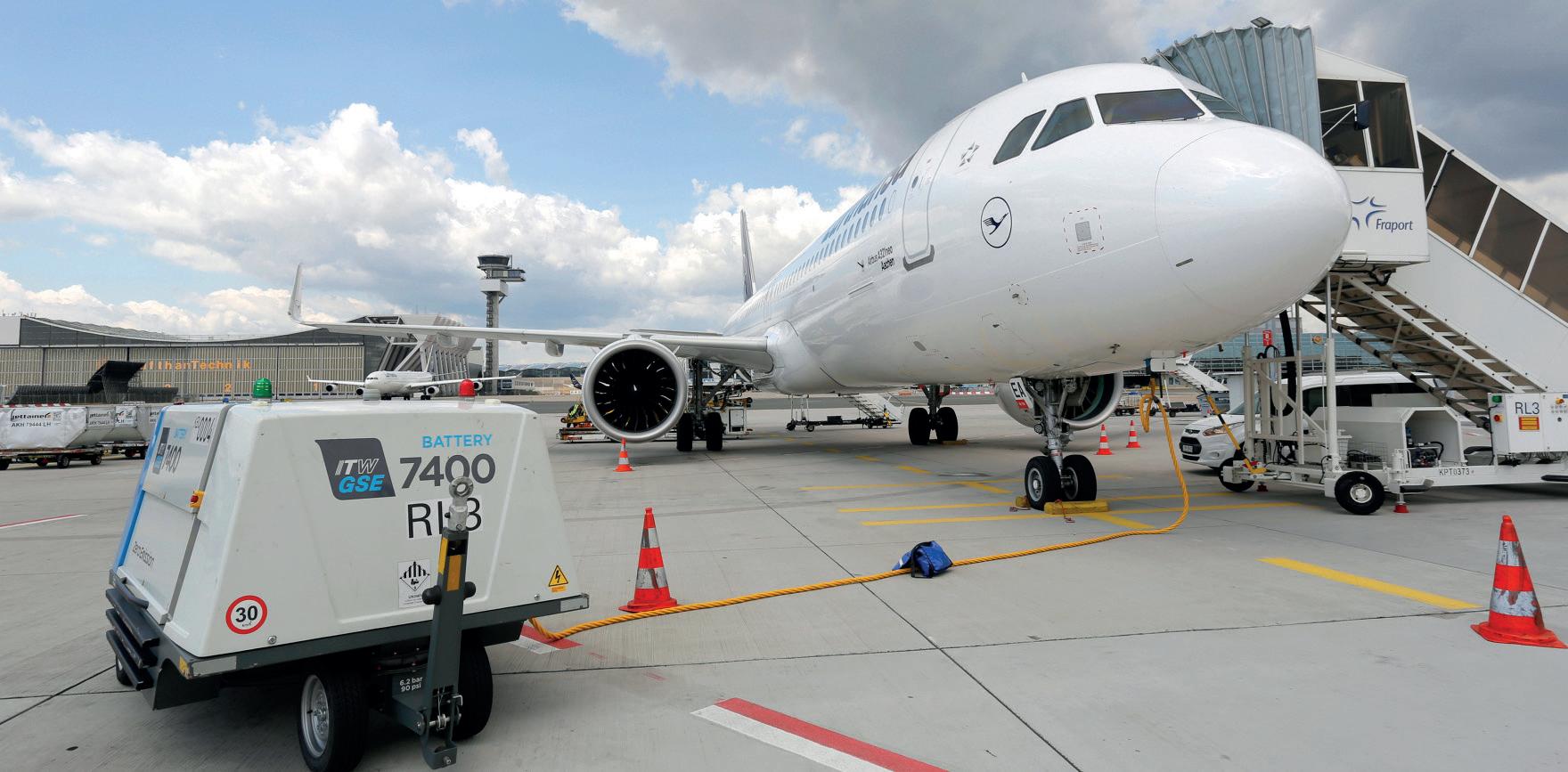
34 LAX story
Justin Wortman and Jon Phillips update us on the role HOK and Arup are playing in the ongoing upgrade of Los Angeles International Airport.
36 Outstanding effort!
Airports big and small across the world have been recognised for their customer experience excellence throughout 2023 in ACI World's annual Airport Service Quality (ASQ) Awards.
40 Time to share?
Improving communication and operations through democratised data can have huge benefits for airports, writes Uri Guterman, vice president of product at AeroCloud.
42 Green
power
Airport World reports on a handful of new sustainability initiatives taking place at airports across Europe.
Director General
Luis Felipe de Oliveira (Montreal, Canada)
Chair
Candace McGraw (Cincinnati, USA)
Vice Chair
Jost Lammers (Munich, Germany)
Immediate Past Chair
Aimen Al Hosni (Muscat, Oman)
Treasurer
Arnaud Feist (Brussels, Belgium)
ACI WORLD GOVERNING BOARD
DIRECTORS
Africa (3)
Emanuel Chaves (Maputo, Mozambique)
Fabrice Grondin (Saint-Denis, Réunion)
Mpumi Mpofu (Johannesburg, South Africa)
Asia-Pacific & Middle East (9)
Mohamed Yousif Al-Binfalah (Bahrain)
SGK Kishore (Hyderabad, India)
Fred Lam (Hong Kong)
Emmanuel Menanteau (Paris, France)
Akihiko Tamura (Tokyo, Japan)
4 Vacancies
Europe (7)
Armando Brunini (Milan, Italy)
Arnaud Feist (Brussels, Belgium)
Jost Lammers (Munich, Germany)
Javier Marin (Madrid, Spain)
Yiannis Paraschis (Athens, Greece)
Augustin de Romanet (Paris, France)
Nazareno Ventola (Bologna, Italy)
Latin America & Caribbean (3)
Ezequiel Barrenechea (Guayaquil, Ecuador)
Mónika Infante (Santo Domingo, Dominican Republic)
Juan José Salmón (Lima, Peru)
North America (6)
Kevin Dolliole (New Orleans, USA)
Deborah Flint (Toronto, Canada)
Joseph Lopano (Tampa, USA)
Candace McGraw (Cincinnati, USA)
Sam Samaddar (Kelowna, Canada)
Roelof-Jan Steenstra (Toronto, Canada)
Regional Advisers to the World Governing Board (10)
Evans Avendaño (Lima, Peru)
Lew Bleiweis (Asheville, USA)
David Ciceo (Cluj-Napoca, Romania)
Seow Hiang Lee (Singapore)
Tan Sri Bashir Ahmad Abdul Majid (Delhi, India)
44
World Business Partners News
We round-up some of the latest ACI World Business Partner stories from across the globe.
46 People matters
Richard Plenty and Terri Morrissey reflect on the importance of paying attention to designing a people-centric working environment.
Mohamed Saeed Mahrous (Cairo, Egypt)
Jorge Rosillo (Galapagos, Ecuador)
Brian Ryks (Minneapolis-St Paul, USA)
2 Vacancies
WBP Observer
Esperanza Morales Martin (Global Exchange)
Correct as of April 2024 AIRPORT WORLD/ISSUE 2, 2024 CONTENTS 6

Solving complex challenges demands a special type of consultant – a consultant that captures the big picture without losing sight of the smallest detail.
Learn how our strategic vision, industry-focused expertise, and pre-decisional support services can help you address challenges.
www.ricondo.com



ADB SAFEGATE applies automation, integration and digitalization to provide an intelligent approach to managing apron activities from landing to takeoff. Our innovative Intelligent AiPRON platform integrates all the systems and processes important to apron operations into a single ecosystem that uses machine learning technologies to unleash the power of data and predictability. Advanced docking systems ensure safe and precise aircraft stops every time, even in poor visibility. Operational data is constantly analyzed and presented to stakeholders in real time to improve decision making, mitigate irregularities and create recommendations to help deliver on-time departures. All of which equals faster, safer and greener turnarounds that boost the customer experience.
MASTERMIND YOUR APRON ONE INTELLIGENT PLATFORM TO MANAGE YOUR AIRSIDE ECOSYSTEM Trusted Advisors.
+1 312-606-0611 | info@ricondo.com © 2024 Ricondo & Associates, Inc. All rights reserved. Ricondo Apr 2024 Airport World Ad_125 x 175_Horz
View from the top
ACI World director general, Luis Felipe de Oliveira, considers the importance of prioritising sustainability in airport planning.
As global passenger traffic stages a remarkable recovery, surpassing pre-pandemic levels by the end of 2024, the aviation industry faces the challenge of accommodating demand while amplifying its societal and economic impact.
By the end of 2024, global passenger traffic is forecasted to grow to 9.7 billion, eclipsing pre-pandemic levels for the first time since the onset of the global health crisis.
Looking ahead, the trajectory of global passenger numbers paints a picture of growth and opportunity. ACI World forecasts indicate a doubling of global passenger traffic from 2024 to 2042, with projections soaring to 2.5 times higher by 2052.
To accommodate this growth, airports worldwide will further require an additional $42 billion for capital expenditure (CAPEX) by 2040 for infrastructure to integrated roadways, rail, and transit facilities. In addition, approximately $2.4 trillion in airport total capital investments will be needed to address the long-term trend in passenger demand to 2040.
However, investment in infrastructure is not the sole concern. Considering the industry’s Net Zero goal, airports are increasingly adopting innovative strategies to balance capacity growth with a commitment to environmental stewardship. While this is no easy feat, it is one that airports prioritise.
Environmental, social, and corporate governance (ESG)
A rapidly increasing number of investors are using a company’s environmental, social, and corporate governance (ESG) performance to screen or drive their investments. While ESG includes metrics and targets, it is also very much about strategy and ensuring strong positive impacts on the world.
Recognising this growing trend, ACI World passed a resolution in 2023 ‘Leading through cleaner energy transition and robust ESG practices’, which calls on regulators to work with all financial institutions to facilitate access to green finance for aviation and to stimulate Sustainable Aviation Fuel (SAF) development.
It urges governments to provide the necessary technical and economic support and required regulatory framework for supporting the airport sector energy transition.
Furthermore, airports are called upon to consider adopting robust ESG practices according to their specific circumstances, engage with ACI in developing the Airport ESG Global Framework, and participate in global efforts to accelerate the deployment of sustainable aviation fuel.
To support its member airports, ACI World in collaboration with NACO and To70, is developing a first-of-a-kind comprehensive ESG framework tailored specifically for the airport industry. Just back from the second round of development, the framework will be presented later this year.
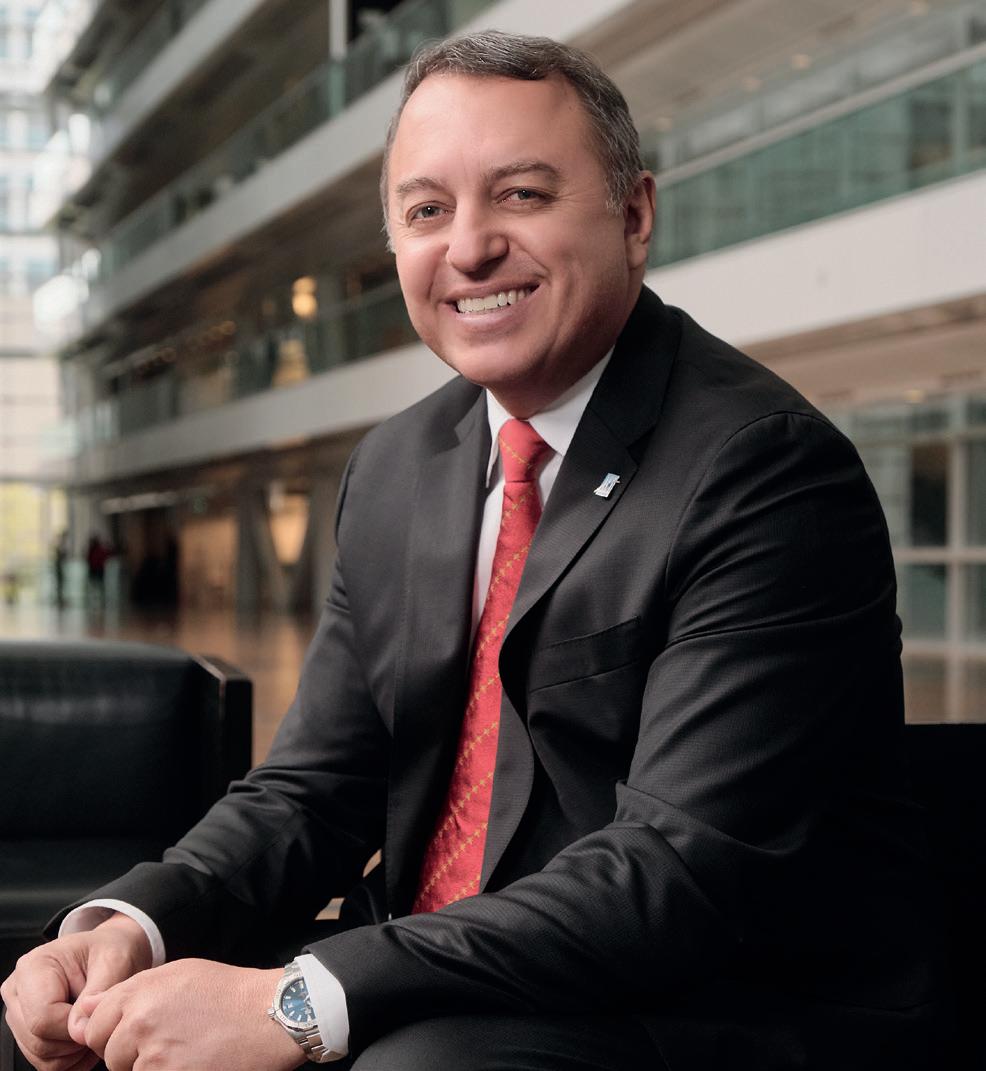
Managing sustainable airport commercial operations
Beyond investors, it is clear that all aviation stakeholders, including concessionaires, passengers, and the public are becoming increasingly aware of the importance of sustainability across all activities and operational sectors.
Through its sub-committee on Airport Non-Aeronautical Revenues and Activities (ANARA), ACI World has just published a comprehensive guide for managing sustainable airport commercial operations. This resource equips airport operators with tools and guidelines to advance sustainability efforts while meeting the needs of all parties involved: airports, concessionaires, passengers, and communities.
The guidance references the 17 UN Sustainable Development Goals, as well as ACI World Sustainability Strategy for Airports Worldwide report and ACI EUROPE Sustainability Strategy for Airports, as its foundational references.
It draws from those goals considered to be relevant and applicable to airports, concessionaires, and third-party supplier relationships, in establishing a framework for a more sustainable environment and experience for passengers.
The only way forward
Sustainability and innovation are integral to airport planning and design; it is in fact, the only way forward. ACI World's proactive initiatives, such as the development of a comprehensive ESG framework and the publication of guidelines for sustainable airport commercial operations, demonstrate a commitment to driving positive change across the industry.
These efforts not only align with global sustainability goals but also pave the way for a more inclusive, resilient, and environmentally conscious aviation sector.
AIRPORT WORLD/ISSUE 2, 2024 9 ACI VIEWPOINT AW
World in motion
The world's busiest airports in 2023, Airport Service Quality (ASQ) customer experience excellence, and a call for greater funding to help Europe’s airports decarbonise.
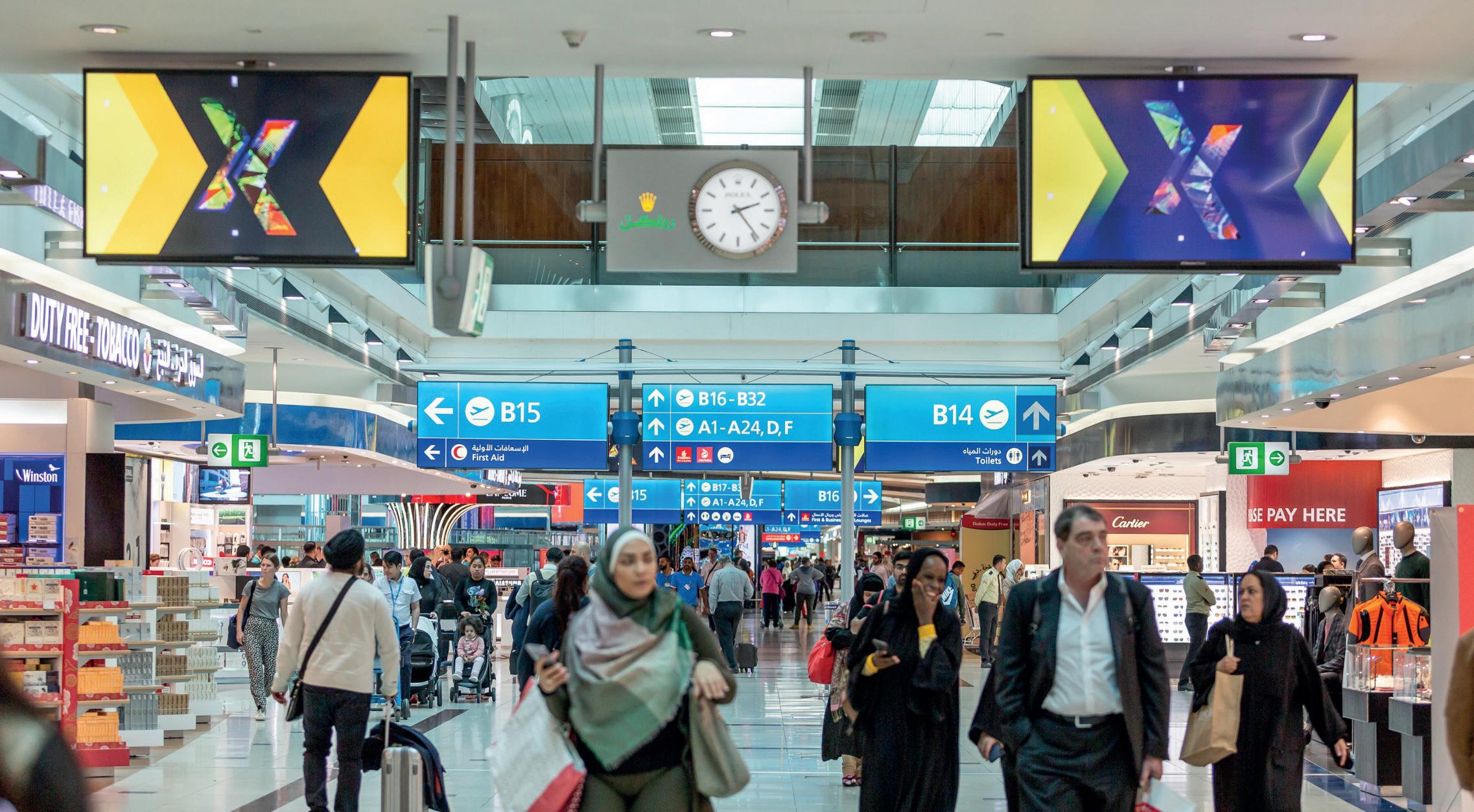
ACI World news: The top 10 busiest airports on the planet in 2023
Hartsfield-Jackson Atlanta (ATL) maintained its status as the world’s busiest airport in 2023, the 104.6 million passengers that passed through its facilities leaving all others in its wake.
Dubai International (DXB) was the second busiest gateway, welcoming 86.9 million passengers during the year to finish ahead of third placed Dallas/Fort Worth International Airport (DFW), despite an impressive 11.4% rise in traffic at the Texas gateway.
ACI World’s highly anticipated preliminary top 10 busiest airports worldwide for 2023, showcase significant shifts driven by the resurgence of international air travel.
The global total passenger forecast for 2023 stands close to 8.5 billion, reflecting a remarkable recovery of 93.8% from pre-pandemic levels. Notably, international traffic recovery drew nearer to that of domestic traffic, emphasising its essential role in propelling the industry’s resurgence and expansion.
The influx of passengers at international airports has been central in bolstering the recovery of hubs reliant on this segment, consequently influencing the composition of the top 10 busiest airports for total passengers.
ACI World director general, Luis Felipe de Oliveira, said: “Global air travel in 2023 was chiefly fuelled by the international segment, propelled by several factors. Among these were the anticipated benefits from China’s reopening and a growing inclination towards travel despite macroeconomic conditions.
“While perennial leaders from the US continue to dominate the top 10 busiest airports for passengers, notably Hartsfield-Jackson Atlanta
International Airport retaining its number one position, there are notable shifts.
“Dubai International Airport jumped to second rank for the first time, while Tokyo Haneda International Airport witnessed a remarkable ascent from 16th position in 2022 to 5th in 2023. Additionally, the unwavering strength of Istanbul and New Delhi airports keep them in top ranks, marking significant progress over 2019.
“Notably, cargo continues to play a key role in world commerce despite the year-over-year decrease. Hong Kong International Airport has maintained the top position, followed by Memphis International Airport and Shanghai Pudong International Airport. Doha International Airport rejoins the top 10, jumping to number 8 with a growth of 6.3% over 2019.
“The rankings highlight the crucial role these transportation hubs play in global connectivity, commerce, and economic development. Airports continue to demonstrate their resilience and adaptability amidst the challenges posed by the ever-evolving landscape of global travel. ACI World remains dedicated to advocating for airports worldwide throughout pivotal stages of policy formulation and to advancing the pursuit of airport excellence.”
Airport rankings are based on data gathered from over 2,600 airports across more than 180 countries and territories globally. This vast dataset places ACI World in a distinctive position as the foremost authority on airport travel demand, ensuring the utmost accuracy and reliability in its rankings.
RUNNING HEAD 10 ACI NEWS AIRPORT WORLD/ISSUE 2, 2024
Simply the best: the world’s customer experience champions
Between them 90 airports received a total of 170 awards in ACI World's Airport Service Quality (ASQ) Awards for the best customer experience at airports worldwide in 2023.
For the first time ever over 400 airports participated in the annual customer experience programme, with the results based on the feedback of 595,000 passenger surveys conducted in all four quarters of the year.
Categories for the Departures Survey included Best Airports by Size and Region, Most Dedicated Staff, Easiest Airport Journey, Most Enjoyable Airport, and Cleanest Airport. While the Arrivals Survey had just one category, The Best Airport at Arrivals Globally, and was awarded to the three airports with the top 20% overall satisfaction scores at arrival – Bengaluru-Kempegowda and Thiruvananthapuram in India and Zayed (Abu Dhabi) in the UAE.
You can read more about the winners and their reaction to their awards on pages 36-38 of this issue.
Reflecting on the results, ACI World director general, Luis Felipe de Oliveira, said: “The global growth of the programme underscores the trust placed in its scientific and live approach, making ASQ the go-to standard for airport customer experience assessment in the aviation industry.
“The future success of airports hinges on the unwavering commitment to delivering a stellar customer experience at every touchpoint. In an era where passenger expectations are evolving rapidly, excellence in customer service isn’t just a goal; it’s the key to ensuring airports remain not just gateways, but memorable destinations in themselves.”
Sharing his insights on the succcess of Latin America and Caribbean airports in the ASQ Awards, ACI-LAC director general, Dr Rafael Echevarne, noted: "These awards highlight the dedication and excellence of airports in Latin America and the Caribbean in providing a superior customer experience.
“The commitment shown by these airports is commendable and sets a high standard for the industry."
ACI Asia-Pacific & Middle East notes that a total of 31 airports from across their region – 27 airports from Asia-Pacific and 4 from the Middle East – received ASQ Awards.

Among the 11 Indonesian airports recognised, Sultan Hasanuddin International Airport and Yogyakarta International Airport have both won five out of six award categories. Oman's Salalah Airport topped among the Middle East airports, with five awards. China and India have six airports each in the recognition.
ACI Asia-Pacific & Middle East’s director general, Stefano Baronci, said: “From the East to the West, airports in Indonesia, Malaysia, Singapore, Republic of Korea, China, India, Oman, UAE and Jordan have excelled to provide a best-in-class service to their customers.
“Although the Asia-Pacific region has been the hardest hit by the pandemic, airports in the region have invested significantly in technology, human resources, and infrastructure to ensure that passengers continue to have a memorable and seamless experience.”
In addition, five airports from Asia-Pacific and the Middle East have been recognised with the ACI World Director General's Roll of Excellence. This honour is conferred on airports that have won multiple Awards over a five-year period in the last 10 years as part of the ASQ programme.
Europe’s airports join call for more EU funding
More than 40 European transport organisations, including ACI EUROPE, have once again joined forces to urge the Council and the European Parliament to increase the Connecting Europe Facility (CEF) budget for transport in the upcoming review of the Multi-Annual Financial Framework.
ACI EUROPE’s director general, Olivier Jankovec, said: “Greater EU financing is a prerequisite for the sector’s ability to decarbonise by 2050. There is no escaping that transport modes incurring harder-toabate emissions, such as aviation, do require more policy and financial support commensurate to the challenge they face.
“While ACI EUROPE joins the wider transport sector’s call for more EU budget for transport, we believe that there should also be a fairer allocation of the funds amongst different transport modes.”
According to the independent study from the consultancies SEO Amsterdam Economics and the Royal Netherlands Aerospace Centre, commissioned by the DESTINATION 2050 alliance, fully decarbonising air transport by 2050 will require funding in excess of €820 billion.
Whilst aviation stakeholders are fully committed to the objectives of the EU Green Deal, and have embraced the Fit for 55 legislative package, the sector will not be able to go it alone in financing its transition.
Indeed, ACI EUROPE believes that the investment needs of airports should be considered as a matter of priority, particularly as they didn’t benefit from the same level of support during the COVID-19 crisis at national level compared to other stakeholders.
As a result, notes ACI EUROPE, the continent’s airports had no choice but to pile on debt, which still remains close to €40bn higher than pre-pandemic levels. This has led to a significant reduction in capital expenditure – with airports investments reduced by €27bn compared to plans over 2022-2024.
All of this at a time when financing decarbonisation, digitalisation, resilience, service quality and capacity have never been more crucial for the well-functioning of European air transport sector and its ability to continue delivering value to European citizens. Europe now faces a looming airport investment crunch, as financing needs are estimated at €360bn by 2040.
AIRPORT WORLD/ISSUE 2, 2024 RUNNING HEAD 11 ACI NEWS
ACI events
2024
May 21-23
ACI Asia-Pacific & Middle East/ACI World Annual General Assembly, Conference & Exhibition Riyadh, Saudi Arabia
2024 July 2-4
ACI EUROPE Annual Congress & General Assembly Istanbul, Turkey
2024 September 7-10
ACI North America Annual Conference & Exhibition Grand Rapids, USA
ACI offices
2024 September 23-26
ACI World Customer Experience Global Summit Atlanta, USA
ACI World
Luis Felipe de Oliveira
Director General PO Box 302 800 Rue du Square Victoria Montreal, Quebec H4Z 1G8 Canada
Tel: +1 514 373 1200
Fax: +1 514 373 1201 aci@aci.aero www.aci.aero
ACI Africa
Ali Tounsi
Secretary General Casablanca, Morocco
Tel: +212 660 156 916 atounsi@aci-africa.aero www.aci-africa.aero
ACI Asia-Pacific & Middle East
Stefano Baronci
Director General
Hong Kong SAR, China
Tel: +852 2180 9449
Fax: +852 2180 9462 info@aci-asiapac.aero www.aci-asiapac.aero
ACI Europe
Olivier Jankovec
Director General Brussels, Belgium
Tel: +32 (2) 552 0978 Fax: +32 (2) 502 5637 danielle.michel@aci-europe.org www.aci-europe.org
ACI Latin America & Caribbean
Rafael Echevarne
Director General Panama City, Panama Tel: +507 830 5657/58 info@aci-lac.aero www.aci-lac.aero
2024
November 5-6
The Trinity Forum Ho Chi Minh City, Vietnam
ACI North America
Kevin Burke
President & CEO Washington DC, USA
Tel: +1 202 293 8500
Fax: +1 202 331 1362
postmaster@aci-na.org www.aci-na.org
Airports Council International (ACI), the trade association of the world’s airports, is a federated organisation comprising ACI World, ACI Africa, ACI Asia-Pacific & Middle East, ACI EUROPE, ACI Latin America-Caribbean and ACI North America. In representing the best interests of airports during key phases of policy development, ACI makes a significant contribution toward ensuring a global air transport system that is safe, secure, efficient, and environmentally sustainable. As of January 2024, ACI serves 757 members, operating 2,109 airports in 191 countries.
RUNNING HEAD ACI NEWS
AW 12 AIRPORT WORLD/ISSUE 2, 2024
Airports Innovate 2024

26-28 November

 Hosted by
Hosted by





Where innovators connect








Rome, Italy
Join us in Rome
Save the date

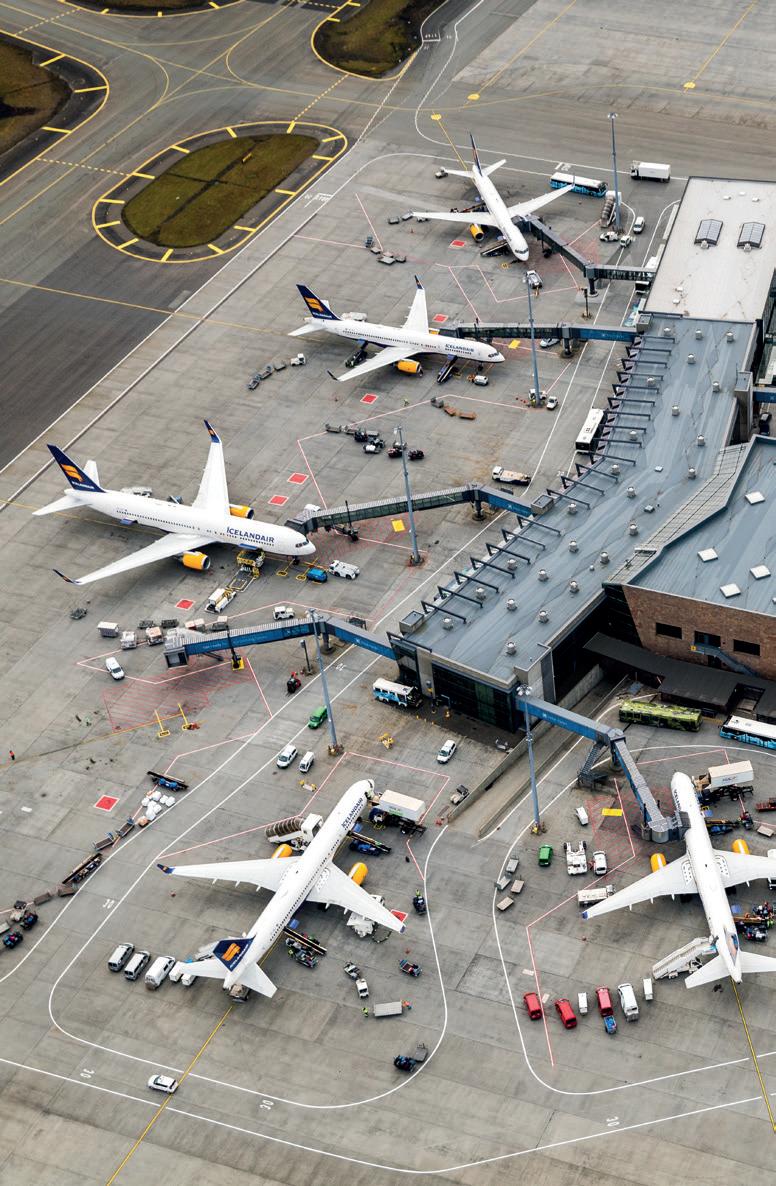
Lean, green and ambitious
Isavia CEO, Sveinbjörn Indridason, tells Joe Bates more about the growth and development plans of Iceland’s Keflavík Airport.
Keflavík International Airport (KEF), Iceland’s gateway to the world, states that it is constantly evolving to keep up with demand and meet the growing needs of passengers and the aviation industry.
And like the rugged and ever changing Reykjanes peninsula around it in south west Iceland which has seen four volcanic eruptions since December 2023, the airport is currently very active in terms of new infrastructure, route development and customer service initiatives.
Last year saw the construction of a new taxiway and the opening of a new baggage hall and an improved border control area as part of the airport’s East Wing extension designed to improve the arrivals experience for non-Schengen passengers.
A host of new retail and F&B outlets also opened at KEF last year. These included popular Danish restaurant, Jómfrúin and new eateries Baked and Elda.
Next on the agenda as part of its new master plan for 2020 to 2045 are further expansion of KEF’s terminal buildings, improving access to the airport and a new taxiway project.
Operator, Isavia, has no doubt that all will be needed as traffic continues to rise at KEF as Iceland, and the world, takes the next step in its recovery from the COVID pandemic.
“We need the new facilities to help us better serve our guests, passengers, and the airlines," says Sveinbjörn Indridason, CEO of Icelandic airport operator, Isavia.
Highlights of 2023
A total of 7.7 million passengers passed through Keflavík in 2023, a huge 27% rise on the previous year and a healthy 7% up on pre-pandemic 2019’s traffic total.
KEF exclusively handles international traffic with all domestic services to and from Iceland’s capital city operating from the smaller and older Reykjavík Airport, located three kilometres from the city centre.
Reflecting on a busy year, Indridason notes that KEF’s new MIKE taxiway is Isavia's first addition to the airfield as the airport’s runways, apron and taxiways were effectively built by NATO or the US military.
The new taxiway allows aircraft to get off and onto runways earlier, increasing the capacity of the runway system, improving airfield safety and speeding up aircraft handling.
The opening of the new and more spacious baggage hall means that KEF’s East Wing is beginning to take shape. The new baggage hall features four expansive and broad baggage claim belts, with provision for adding another in the future.
As you would expect, the new arrivals area for non-Schengen passengers is designed to enhance the airport experience for those arriving from outside of the Schengen area by reducing queues at border control.
So, did all of the new infrastructure additions and soaring passenger numbers mean that 2023 was a good year for KEF?
“It was definitely a good one,” enthuses Indridason. “Our passenger growth and expanding route network is down to many factors. Firstly, we have an excellent staff, a group of people who work tirelessly for the airport to advance its position and status.
“If we put these stats into a larger context, we quickly arrive at the fact that the number of destinations in relation to the population in the domestic market is unheard of. The inherent value in these numerous flight connections is enormous when it comes to the quality of life and prosperity in Iceland because they are one of the key drivers of economic growth.
14 AIRPORT WORLD/ISSUE 2, 2024 AIRPORT REPORT: KEFLAVÍK

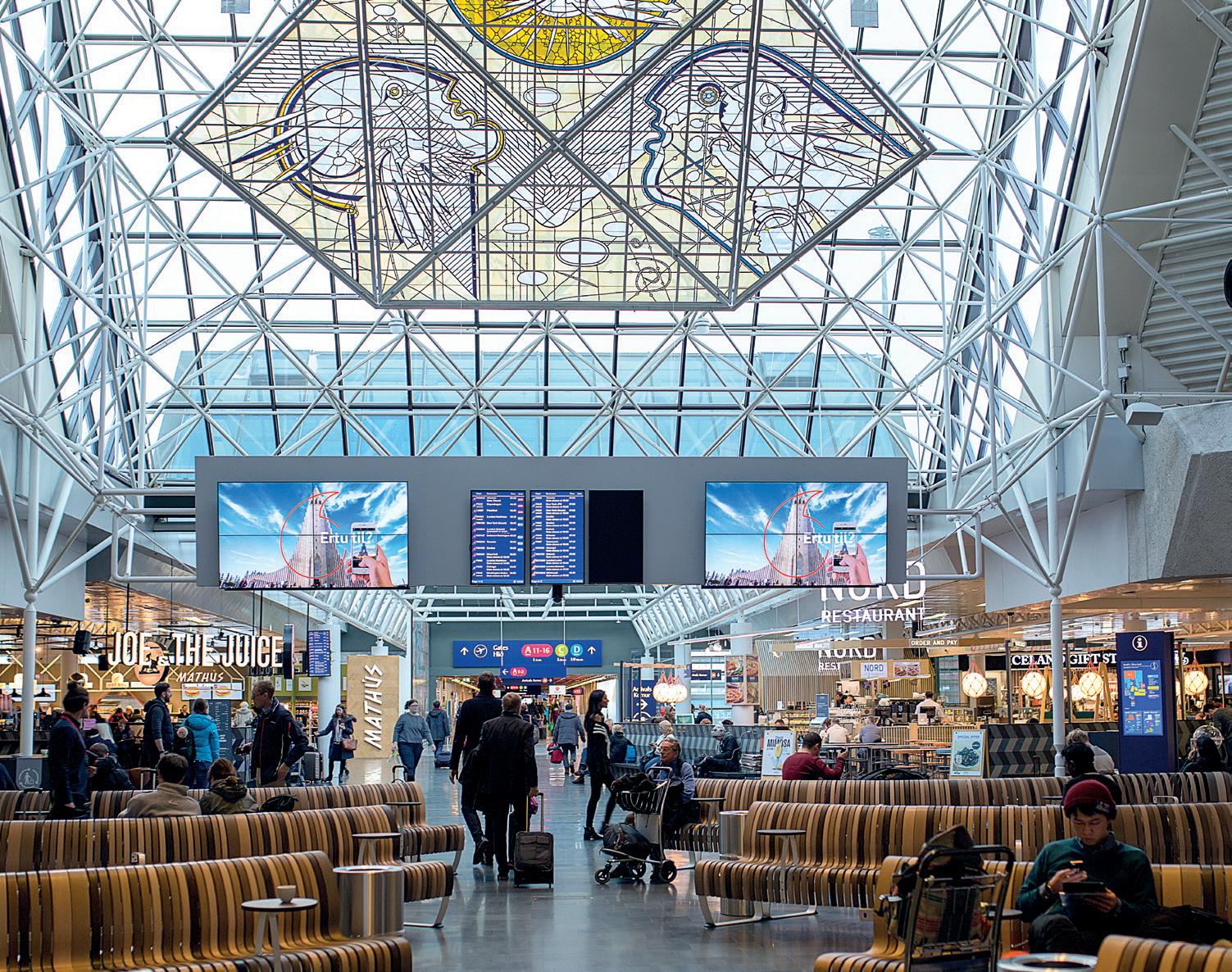
“Keflavík Airport has served a key role, along with the hub airlines, in connecting Iceland with the continents on both sides of the Atlantic. Our strategy is to connect the world through Iceland. It is an ambitious goal, but a feasible one, and something we work towards achieving every day.”
Reviewed master plan for Keflavík Airport
In line with its policy of updating its master plan for Keflavík Airport every five years, Isavia recently fine-tuned its current plan, Masterplan KEF, covering the period 2020-2045.
Valid for the next two decades, the master plan remains largely based on the previous development plan covering 2015 to 2040.
The ongoing East Wing expansion is the largest project in Isavia's history, and will feature gates capable of handling two different flights at the same time.
Next up is the construction of a new building connecting KEF’s North and South Buildings, which will be used by all passengers passing through the airport. The new connector building is expected to vastly improve services for passengers with connections via Keflavík Airport.
To put things in perspective, when fully open, the new East Wing and connector building will lead to a 70% increase in the size of the airport's terminal buildings.
Sustainability and benefit to the community are said to be the guiding principles of the master plan. Indeed, Indridason notes that Isavia’s construction programme will adhere to its sustainability policy, ensuring that all new buildings at KEF are BREEAM certified, in other words internationally recognised for their sustainable construction.
Social, environmental and economic impact
How important to Isavia and KEF is the sustainable development of the airport and being a good neighbour to local residents?
“It is very important to us as sustainability is a guiding principle in all of Isavia’s activities, and the company focuses on pulling its weight when it comes to sustainability in its operations,” says Indridason.
“We are very conscious about our impact on the neighbouring municipalities – both for the positive and the negative. We are very
reliant on these municipalities for employees, contractors and other resources, for example, but we also know that having an international airport on their doorstep has its downsides.
“We try our best to accommodate for the negative effects and enjoy a close dialogue and co-operation with our neighbouring communities, which I believe has helped created a win win situation for everyone.”
He goes on: “In the past few years, Isavia has taken large and important strides towards sustainability, and the company’s sustainability policy is accompanied by a five-year action plan in which our emphases, goals and criteria in the field are set out.
“They were selected with reference to the company’s policies, comments from external stakeholders, our commitment to the UN Global Compact, the United Nations Global Goals and government priorities.
“Isavia issues its annual reports pursuant to GRI standards and its special clauses regarding airports. The most recent report gives an overview of the company’s operations in 2023 and their impact on the economy, the environment, the community and human rights. The report is also submitted as a progress report for our support of the UN Global Compact.
“It is a statement of our intent to continue to work towards the ten basic principles of the United Nations regarding social responsibility in the fields of human rights, labour, the environment, and anticorruption measures.”
KEF certainly boasts some impressive green credentials. The airport is one of only a few in the world to use 100% renewable energy courtesy of geothermal or hydropower, and this has gone a long way in helping it reach Level 3+ ‘Neutrality’ status in ACI’s Airport Carbon Accreditation programme.
The achievement is in line with Isavia’s goal of reaching net zero operations by 2030.
Isavia’s latest financial statement shows that KEF generated in excess of ISK45,058 million (just under €300 million) in revenue in 2023 and is directly responsible for around 1,247 jobs.
In terms of measuring the social value of Keflavík Airport's operations, Indridason says Isavia launched project to more accurately assess its impact and work more purposefully towards raising this value in co-operation with business partners and suppliers.
15 AIRPORT WORLD/ISSUE 2, 2024 AIRPORT REPORT: KEFLAVÍK
“The project Value2Society was used for the assessment and social value was measured in positive and negative value,” Indridason explains. “The results indicate how Keflavík’s operations are fulfilling the company's purpose of increasing the quality of life and prosperity in Iceland and provide a better analysis of improvement opportunities for the operations.
“The goal is to maximise the company's profitability and value creation through the entire value chain, while systematically working on improvements in environmental and social issues where human rights and people's quality of life are at the forefront.
“To better understand the impact of Isavia’s value creation it is interesting to compare Isavia’s income with the social value creation. In 2022 the social value creation was 1.5 times the company's revenue, and if we take the supply chain into account, the ratio is more like twofold."
Traffic trends
Almost 8.5 million passengers are expected to travel through Keflavík Airport (KEF) this year, according to the airport's passenger forecast for 2024.
If the forecast proves accurate, KEF will handle a healthy 9.6% more passengers this year than in 2023, making it the third best year in its history after the 8.8 million and 9.8 million passengers that used the airport in 2017 and 2018 respectively.
The 2024 traffic projection predicts that nearly 2.4 million foreign tourists will arrive in Iceland through the airport. If the projection holds, it will be the highest number of foreign tourists to ever visit Iceland.
During summer 2024, 25 airlines will operate scheduled flights to 82 destinations, and 20 airlines will serve 69 destinations during the winter months.
When considering the months classified as winter months by KEF (January, February, March, November and December), passenger numbers are expected to grow by 15.2% or 354,000. During the summer months (April to October), passenger numbers are projected to increase by 391,000, representing a 7.2% year-onyear rise.
The forecast projects that transit passengers will account for approximately 30% of the total passenger count in 2025, compared to around 27% in the current year.
Indridason notes that this indicates a higher percentage of passengers using KEF as a connecting hub without staying in Iceland. The highest ever percentage of connecting passengers occurred in 2018 at around 40%.
He adds “We are forecasting 8.5 million passengers in 2024 and longer-term forecasts assume that we will reach 12-14 million passengers by 2033.”
Airlines and route network
The top five airlines at KEF in terms of market share are easyJet, Icelandair, Play, SAS and Wizz while the most popular routes are Amsterdam, Boston, Paris, Copenhagen and London.
And KEF’s route network continues to grow, Aalborg, Athens, Porto and Hamilton (Play), Detroit (Delta and Icelandair) and Tel Aviv (Icelandair) being added in 2023 and Calgary (Westjet), Halifax and Pittsburgh (Icelandair), Split (Play) and Stuttgart (Eurowings) this year.
The list doesn’t include new carriers on existing routes, such as the new easyJet service to Paris Orly launched in March 2024, which means that the low cost carrier now serves seven destinations from KEF – Bristol, Edinburgh, London Gatwick, London Luton and Manchester in the UK, Milan in Italy, and Paris, in France.
Recruiting new staff
Airports globally are struggling to recruit staff to replace those that left or they were forced to let go during the global pandemic. Has this been an issue in Iceland where the recruitment pool is so much smaller than most other countries?
Indridason replies: “We were fortunate enough to be quite successful in recruiting staff post the pandemic. When the pandemic hit us, we made decisions to keep knowledge within the airport because we knew that it would both be expensive and time consuming to recruit and retrain people when travelling would resume.
“At the beginning of 2022 we took a leap of faith and started recruiting and training people before Iceland lifted the travel restrictions that were in place. That gave us the opportunity to be ready when we reached the pre-pandemic passenger numbers in July 2022.
“However, what we are facing now is a lack of resources when it comes to developing the airport. The current and upcoming constructions are of such a magnitude that it will affect the economy in Iceland and there are not enough resources currently in the country to accommodate our needs.
“We will find a solution going forward, but it is important for us to look at this as one of our main risk factors.”
Volcanic activity in Iceland
The recent volcanic eruptions in Iceland have rightly grabbed news headlines across the world as a spectacular example of the power of Mother Nature. Indridason is however happy to reveal that they caused no disruption to daily operations at Keflavík, which is located around 50 kilometres west of Reykjavík.
“The recent volcanic activities at Reykjanes have required various responses from us but, fortunately, have not adversely impacted on operations at Keflavík,” he says.
“We have a strong and focused emergency response team, and our employees are extremely qualified to respond to all kinds of external disturbances. We live and operate in Iceland and there is a huge resilience imbedded in the Icelandic culture to cope with the sometimes-harsh nature.
“The eruptions didn’t impact on flights in and out of Iceland. The airport itself is positioned in a way that lava will not threaten the infrastructure itself, but it can influence our access to electricity and water. The feeding of hot and cold water was, for example, disrupted earlier this year, but we still managed to maintain undisrupted operation at the airport.
“Today we are self-sufficient regarding electricity and hot water, and we will continue to improve our contingency plans to stay alert.
“Iceland is a volcanic island, and we show nature full respect but having said that, according to our risk assessment, these recent events didn't call for anything that hasn't already been implemented.”
AIRPORT REPORT: KEFLAVÍK 16 AIRPORT WORLD/ISSUE 2, 2024
AW


Design and build
Joe Bates considers the infrastructure development challenges facing airports and reviews 12 different projects that are either planned, underway or have been recently completed across the globe.
With global passenger traffic on the rise and set to exceed pre-COVID levels by the end of the year, the need for new infrastructure to ensure that airports can keep pace with demand and meet the needs and expectations of the travelling public is firmly back in the spotlight.
In truth, the need for new airports, terminals and runways never really went away, it just wasn’t the top priority for many during the global pandemic which at its height, led to some gateways handling just a fraction of their usual daily passenger totals or nobody at all.
However, while some airports scrapped, halted construction or delayed the start of key projects during the pandemic, others actually decided to bring their capital development programmes forward to take advantage of the lack of activity at their facilities, some of which you will be able to read more about later on in this article.
ACI World has certainly never lost sight of the infrastructure challenge ahead for airports, with director general, Luis Felip de Oliveira, reminding us in the last issue that approximately $2.4 trillion in airport total capital investments will be needed to address the long-term trends in passenger demand to 2040.
And in North America, ACI-NA’s 2023 U.S. Airport Infrastructure Needs Report: Growing Needs Heighten Urgency to Modernize America’s Airports revealed that US airports faced a backlog of planned and necessary infrastructure projects that would total at least $151 billion over the next five years.
The huge infrastructure need possibly helps explain why US airports account for five of the 12 airport development projects featured in this article, and why we also have a separate article on the multi-billion transformation of Los Angeles International Airport (LAX) on pages 34-35 of this issue.
The US airport development projects covered in this article are the planned new Terminal One and Terminal 6 at New York’s John F Kennedy International Airport; Houston George Bush Intercontinental Airport’s Terminal B Transformation Program; the newly revamped Nashville International Airport; DFW’s Central Terminal Area Expansion Program; and Fort Lauderdale’s planned new Terminal 5.
Elsewhere in the world we review the ambitious new terminal planned for Florence Airport in Italy; new terminals at Kuwait International Airport in Kuwait and Tiruchirappalli International Airport in India; the next phase of the development of Madinah Airport in Saudi Arabia; the construction of Noida International Airport in India; Vietnam's new Long Than International Airport; and a proposed new gateway in Cartagena, Colombia.
New terminals at New York’s John F Kennedy International Airport
Terminal 6 and New Terminal One (NTO) are key projects in the historic $19 billion redevelopment of John F Kennedy International Airport that the Port Authority of New York and New Jersey (PANYNJ) say will transform the airport into a “21st century global gateway set to rival the best airports in the world from kerb to gate”.
Both new terminals are being privately built as a result of publicprivate partnerships with the Port Authority, which is developing new roadways, parking facilities and support infrastructure for the new additions.
The Port Authority and JFK Millennium Partners (JMP) – the company selected to build and operate Terminal 6 – recently marked one year since breaking ground on the $4.2 billion terminal with a sneak peek of the facility through a new animated rendering from terminal frontage to gate.
18 SPECIAL REPORT: MASTER PLANNING & DESIGN AIRPORT WORLD/ISSUE 2, 2024
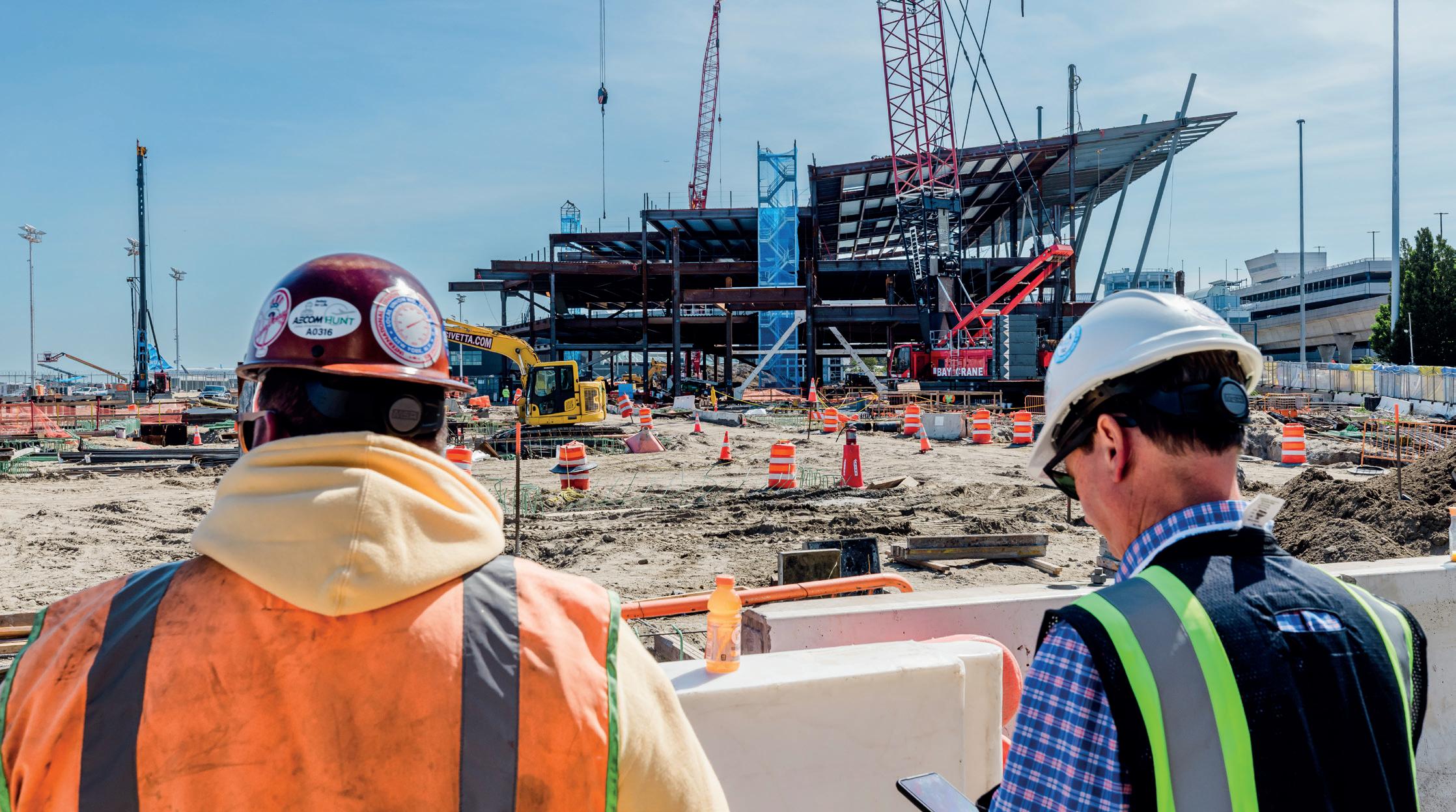
and recently closed Terminal 2 and former Terminal 3 – continues at a pace ahead of a planned first phase opening in 2026.
Throughout construction, the project is expected to create more than 4,000 jobs, including 1,800 union construction jobs and direct wages of $1.9 billion.
“Watching the steel frame of a new Terminal 6 taking shape is a tangible sign that JFK’s transformation into a world-class global gateway is well underway,” said PANYNJ's executive director Rick Cotton.
While George Casey, JFK Millennium Partners' chairman and the chair and CEO of Vantage Airport Group, which leads Terminal 6 development and also spearheaded the development of LaGuardia Airport’s new award-winning Terminal B, enthused: “To see our hard-working, talented team and partners develop the new JFK Terminal 6 from the ground up is tremendously exciting.
"With each construction milestone and this one-year mark, we’re closer to welcoming passengers to an extraordinary new airport facility that will provide tremendous benefits to the local community, city, and state that Terminal 6 will proudly serve."
JMP is developing Terminal 6 in two phases, with the first five gates set to open in early 2026 and construction expected to be completed by 2028.
Lufthansa Group has announced it will move to the new terminal, operating flights to several European gateways and creating a world-class lounge experience for guests travelling on its group of airlines that includes Lufthansa, SWISS International Air Lines, Austrian Airlines, and Brussels Airlines. Advanced discussions with other air carriers are underway.
New York City-inspired retail, dining options and amenities totalling nearly 100,000 square feet is planned at Terminal 6 to create a unique New York sense of place. Selection of the future food and beverage, retail and duty-free concession brands is underway, with partners to be announced once chosen.
Meanwhile, work on the $9.5 billion New Terminal One at JFK – being built on sites occupied by the existing Terminal 1
The first phase opening of the NTO will include new Arrivals and Departure Halls and 14 new gates, however, there is much more to come as when fully built in 2030, the new 2.4 million square foot complex will be the largest terminal at JFK and nearly the same size as LaGuardia Airport’s two terminals combined.
According to the Port Authority, the new terminal will be a sustainably designed state-of-the-art international-only terminal with 23 gates that boasts “naturally lit public spaces, cutting-edge technology and an array of amenities, all designed to enhance the customer experience and compete with some of the highest-rated airport terminals in the world.”
The huge new complex is being built and will be operated by the New Terminal One consortium, which along with the PANYNJ and commercial partner Unibail-Rodamco-Westfield (URW) recently unveiled the commercial vision for the new terminal.
“The launch of the commercial programme for the New Terminal One is an important milestone as we advance towards our scheduled opening in 2026,” said Dr Gerrard Bushell, president and CEO of The New Terminal One.
“We are proud to partner with URW Airports to launch a world-class retail experience featuring global brands and local New York businesses, reflecting the dazzling array of offerings that our great city is known for. Our food and beverage selection will showcase a rich diversity of cuisines and flavours inspired by the tapestry of cultures that make up New York City, while driving real economic opportunities in our community for generations to come."
The NTO is being privately financed by a consortium of labour, operating and financial partners that include Ferrovial, Carlyle, JLC Infrastructure and Ullico. The terminal will be constructed by a design build team led by AECOM Tishman, which has managed the construction of some of the world’s most iconic buildings, and Gensler, a leading global design and architecture firm.
19 AIRPORT WORLD/ISSUE 2, 2024
Construction of the terminal is on schedule, with the last beams of steel expected to be erected this summer and the first gates to open in 2026.
SPECIAL REPORT: MASTER PLANNING & DESIGN

Vineyard on the roof of Florence’s new terminal
In one of the most innovative designs ever unveiled for an airport, Rafael Viñoly Architects has drawn up plans for a new green terminal at Florence’s Amerigo Vespucci Airport in Italy that includes a 19-acre vineyard on its roof.
The unique sloping rooftop is set to feature 38 rows of productive vineyards which will help contribute to the terminal’s LEED Platinum sustainability rating and make it “a landmark for the city’s sustainable future”.
Designed to pay homage to Tuscany’s wine producing heritage, the vineyards on top of the 50,000sqm terminal will be cultivated by a local vintner from the region and the wine it produces will be crafted and aged in specialised cellars beneath the roof.
Other sustainability features included in the new terminal, which is expected to handle around six million international passengers annually, include:
• A combination of standard solar panels and translucent photovoltaic panels, which are woven throughout the structure, including in between the vineyard rows
• Evaporative cooling from the planting beds and the shading of the vineyard plant nearly eliminates solar gain through opaque roof surfaces
• An HVAC system that shifts between hybrid cooling and mechanical cooling, depending on the season
• Rainwater harvesting designed into the structural elements that house the vineyards, and the reutilisation of purified wastewater to reduce the building’s need for potable water
• Lighting systems will be developed around LED lighting with astronomical time clocks and daylight harvesting to minimise the use of artificial lighting.
For those wondering what impact aviation will have on the produce from the rooftop vineyard, the designers note that the roof of the building will be planted with non-fruit-bearing vines and the fruit-bearing varieties will be planted on the berm (a mound made of soil and earth that lies underneath the roof
of the first third of the length of the building) that marks the eastern origin of the roof and the land to the east of that.
The fruit-bearing vines will also be at least 400 metres away from the nearest aircraft or fuel depot in a location where the prevailing winds and the geometry of the building itself keep pollutants away from the plants.
Rafael Viñoly Architects promises that the terminal’s interior will feature a sense of place design and facilities to enhance the passenger.
It also argues that by placing Arrivals and Departures facing each other across a large ‘Piazza’ at the centre of the building, circulation into and out of the terminal will be streamlined, while also providing access to mass transit, parking and retail that serves the local community as well as travellers.
In addition to the new terminal, the airport’s existing runway is being reoriented by 90 degrees and lengthened so that it can handle bigger aircraft that are currently restricted from flying to Florence by hills surrounding the airport and the runway’s length.
The airport is also set to get a new light rail system that creates a swift and sustainable way for customers to get around.
Speaking about Florence and the new airport, in 2022 the late Rafael Viñoly, principal and founder of Rafael Viñoly Architects, said: “Florence is maybe the only city in the world that does not need to be promoted. It represents the very idea of culture; a culture that is productive, intellectual, artistic, and always practical and pragmatic. Florence is a place where things become permanent landmarks because they have a fundamental sense of internal logic and quality.
“Because the airport, which is the door to the city and its culture, is so extremely close to the city centre, this must be an urbanistic project, not an isolated design exercise that is divorced from everything but the technical demands of aviation and the competition for passengers.
“The ambition and sensitivity of the scheme is a testament to the collaborative spirit of the city’s leadership, the aviation authorities and the airport operator.”
The project will be completed in two phases, with phase one anticipated to be completed in 2026 and phase two in 2035.
20 SPECIAL REPORT: MASTER PLANNING & DESIGN AIRPORT WORLD/ISSUE 2, 2024
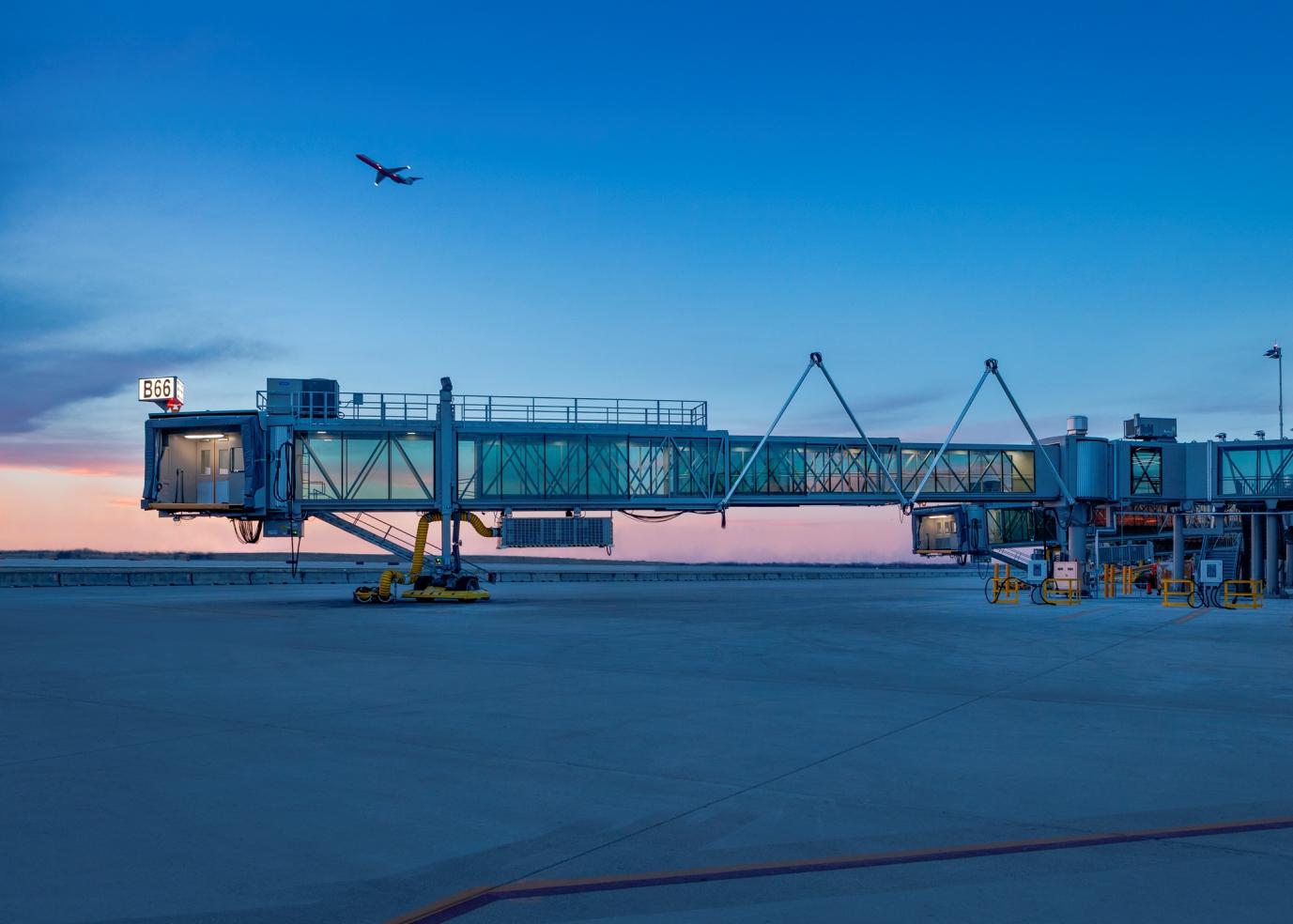


Focusing on tomorrow’s
RS&H delivers infrastructure solutions for a more connected future where everyone can thrive. We translate experience into insight to design an exceptional journey.
rsandh.com
#DrivenToCare
solutions today
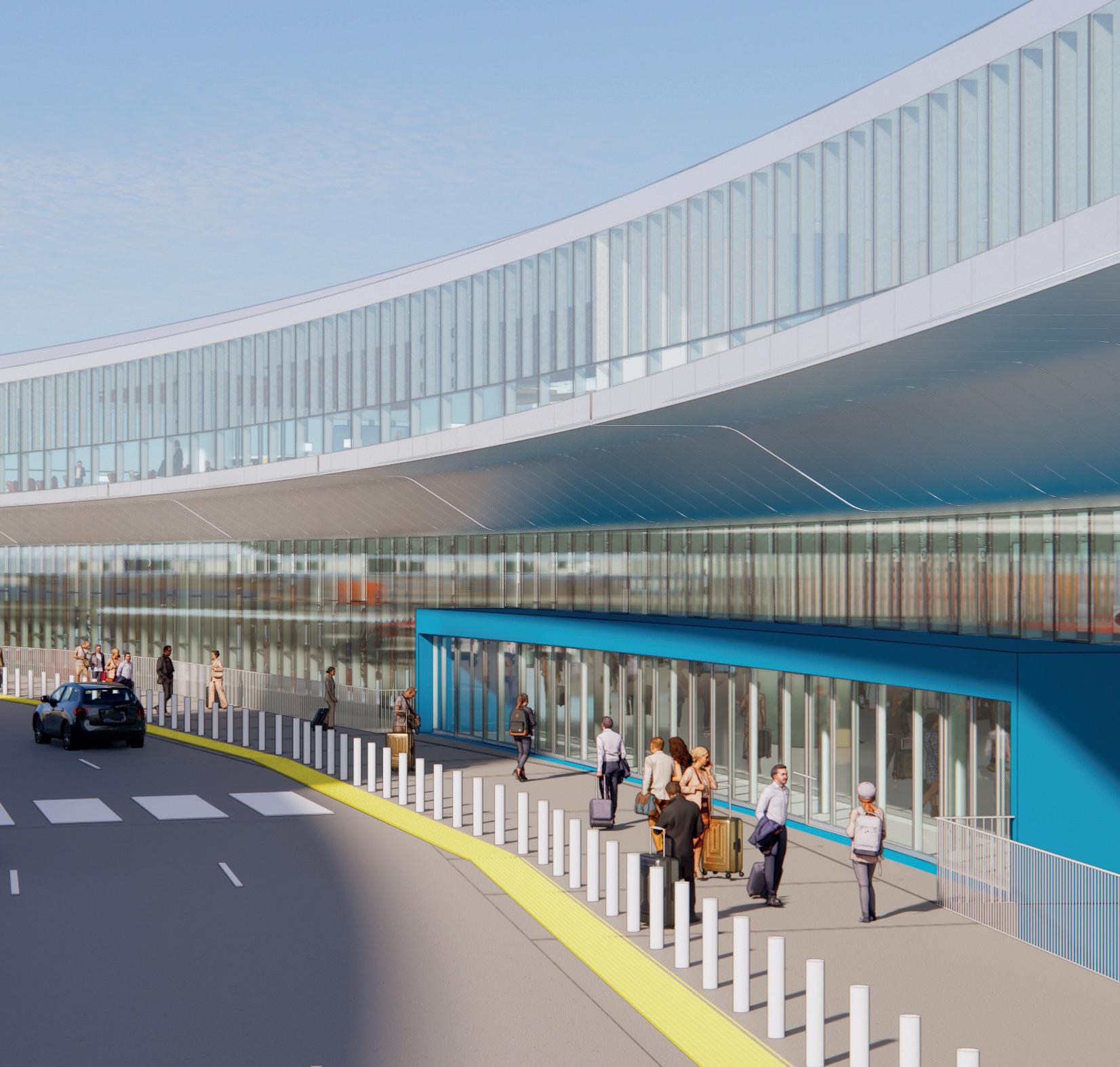
Central Terminal Area expansion at DFW
HOK is part of the design team for the Central Terminal Area Expansion Program at Dallas/Fort Worth International Airport (DFW).
The project includes the addition of two new concourse piers at Terminals A and C as well as the full modernisation of Terminal C. Nine new gates will be added to the terminals.
It is envisaged that the updates will streamline the traveller experience at DFW, refreshing Terminal A in support of the new concourse pier and upgraded Terminal C. The project includes renovating and expanding the ticketing hall, security checkpoint, baggage claim hall and related support facilities.
The terminal renovations will feature spacious halls to improve passenger flow and support wayfinding. Floor-to-ceiling windows will offer abundant natural light, featuring high-tech glass that adapts its tint to sunlight intensity and solar heat gain. New, prominently displayed gate signage will help passengers identify their gate locations from a distance.
The Central Terminal Area Expansion Program is employing modular construction to accelerate the construction timeline. This ‘plug-andplay’ construction method is said to increase flexibility when adding the two new concourse piers while minimising disruptions to operations. The project team is building these large-scale modules off-site before transporting and installing them.
According to HOK, innovative technology incorporated into the project will enhance the airport’s operational efficiencies. Terminals A and C will utilise one of the most comprehensive building management systems in the aviation industry to optimise operations and reduce energy use. Nova Lift Systems at all gates will improve accessibility, enabling passengers with motorised wheelchairs to use them up to the gate rather than leaving them at check-in.
“The Central Terminal Area Expansion Program is leveraging the latest technology to design and deliver modern airport terminals that

will transform the travel experience at DFW,” says David Mason, HOK’s principal-in-charge. “We’re committed to providing a superior, faster and cost-effective design solution for the airport.”
The Central Terminal Area Expansion Program is scheduled for completion prior to 2030. The project team is a joint venture between HOK, Austin Commercial, Azteca Enterprises, Alpha & Omega and Muller & Muller, Ltd.
Upgrading existing airport and building a new one in
Cartagena
Colombia’s Infrastructure agency ANI and Operadora Internacional Aeropuerto de Cartagena (OINAC), a subsidiary of concessionaire Termotécnica Coindustrial, have signed a $230 million contract to build a new international terminal and upgrade the existing terminal at Cartagena’s Rafael Núñez International Airport.
The upgrades will allow the gateway to handle up to eight million passengers annually, but are widely viewed as a temporary solution before the opening of a proposed new airport on a 864 hectare site in Bayunca, north of Cartagena, in around 2033.
Precise information about the new airport project is hard to find, but it has been suggested that it will initially be equipped with a 70,300sqm terminal and a single runway, giving it the capacity to handle up to 11 million passengers per annum. This is expected to rise to up to 45 million passengers per annum with future expansion that will include the addition of a second runway.
The new airport is backed by Colombian infrastructure developer and investor, Odinsa (Groupo Argos); Macquarie, an Australian private investment fund operator; and Conecta Caribe, a Cartagena firm with investments in the hotel and real estate sector.
Rafael Núñez Airport is third biggest airport in Colombia, after Bogota's El Dorado and Medellín’s José María Córdova's Rionegro Airport.
22 SPECIAL REPORT: MASTER PLANNING & DESIGN AIRPORT WORLD/ISSUE 2, 2024
Noida International Airport.
A glimpse of the future at DFW.

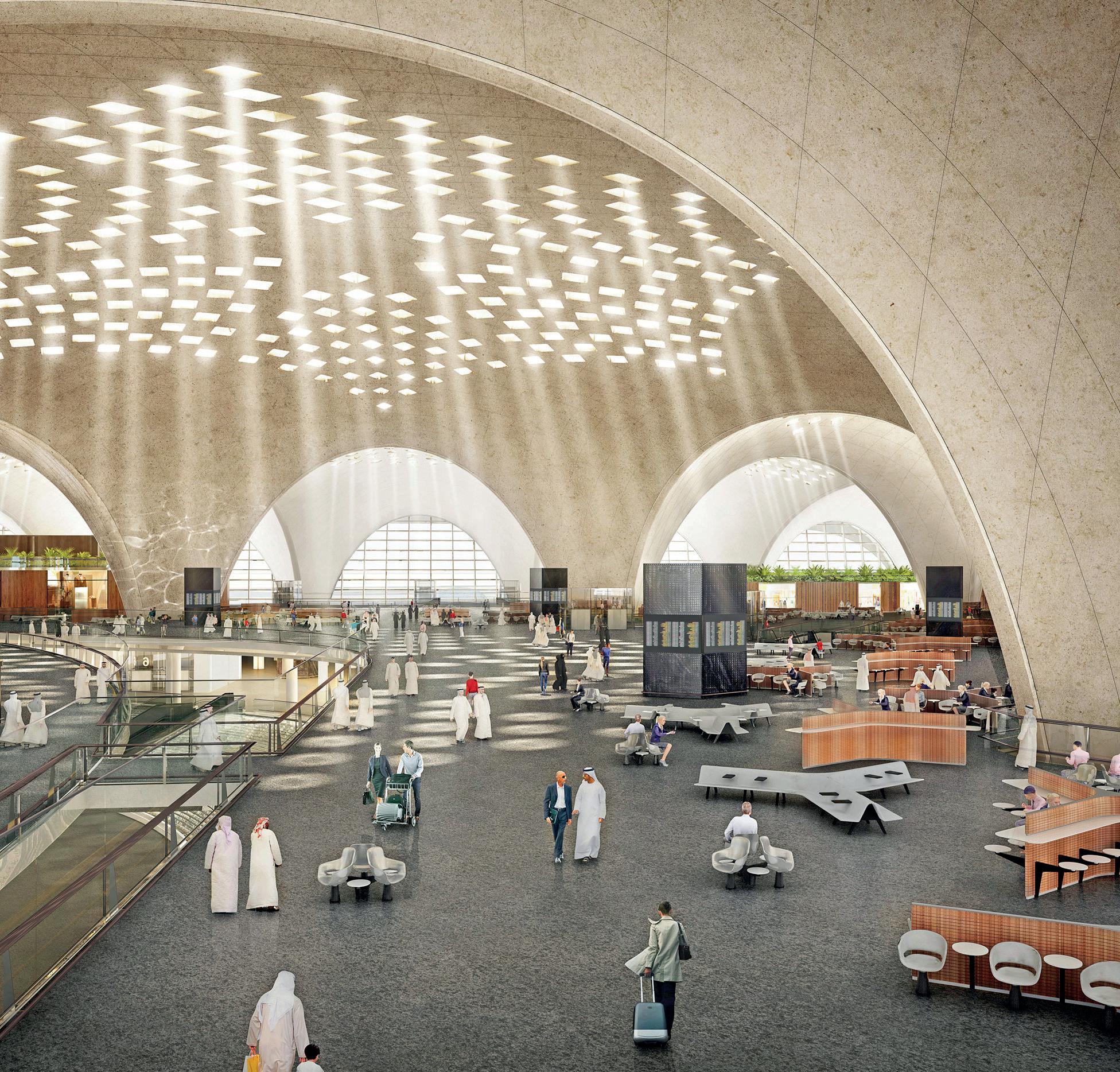
New Noida International Airport to open later this year
With its construction nearing completion and navigation equipment currently being installed, India’s newest gateway, Noida International Airport, is expected to open in late 2024, the exact opening date depending on how work progresses over the next few months.
The airport on the outskirts of New Delhi has been given the IATA code ‘DXN’ and recently announced that Indigo – one of the fastest growing airlines in the world – would be its launch carrier.
Under the arrangement, DXN and IndiGo will work together towards developing and strengthening the air connectivity within Uttar Pradesh and beyond.
DXN’s CEO, Christoph Schnellmann, said: “We are excited to sign this MoU with IndiGo, which has a strong base both in domestic and international markets. The partnership between NIA and IndiGo will not only help bolster air connectivity but also innovate, ensuring an exceptional customer experience for our customers alike.
“By leveraging IndiGo’s extensive route network and expertise, we aim to provide our passengers with unparalleled connectivity and an exceptional travel experience.”
Viewed as an alternative to Delhi’s Indira Gandhi International Airport, Noida is being built, and will be operated by, Yamuna International Airport Private Limited (YIAPL), a special purpose vehicle set up for the job and 100% owned by Zurich Airport International.
It will initially have a capacity of 12 million passengers per annum before being expanded to accommodate 30mppa and eventually 70mppa by the end of the concession in 2061.
Schnellmann notes: “As one of the world’s largest urban agglomerations, India’s National Capital Region deserves a second airport. Noida International Airport will make this long-standing dream a reality. We look forward to welcoming passengers, customers, and partners at the region’s new economic and cultural hub.”
The master architect team for DXN’s passenger terminal consists of Grimshaw, the Nordic Office of Architecture, Haptic and STUP. Their design is said to merge Swiss efficiency and Indian hospitality.
New Terminal 2 at Kuwait International Airport
Architects Foster + Partners reveal that the design of Kuwait International Airport’s new Terminal 2 is rooted in a sense of place, responsive to the climate of one of the hottest inhabited environments on earth, and inspired by local forms and materials.
It notes that the terminal has a trefoil plan, comprising three symmetrical wings of departure gates. Each façade spans 1.2 kilometres and all extend from a dramatic 25-metre-high central space.
“The terminal balances the enclosure of this vast area with a design that is highly legible at a human scale – for simplicity and ease of use there are few level changes,” says Foster + Partners.
“To further aid orientation, the building is planned under a single roof canopy, punctuated by glazed openings that filter daylight, while deflecting direct solar radiation.
“The canopy extends to shade a generous entrance plaza and is supported by tapering concrete columns, their fluid, organic forms draw inspiration from the contrast between the solidity of the stone and the shape and movement of Kuwait's traditional dhow sailing boats.”
Drawing on the region's culture of hospitality and welcoming guests to Kuwait, the design aims to create an elegant and memorable arrival sequence for passengers, which includes a baggage reclaim area surrounded by cooling cascades of water.
The design also features a grand new landside access sequence from the south and a “lush oasis” of landscaping close to the building, with strands of drier planting and species native to the desert climate extending further away from the terminal.
23 AIRPORT WORLD/ISSUE 2, 2024
SPECIAL REPORT: MASTER PLANNING & DESIGN
Image courtesy: Foster + Partners
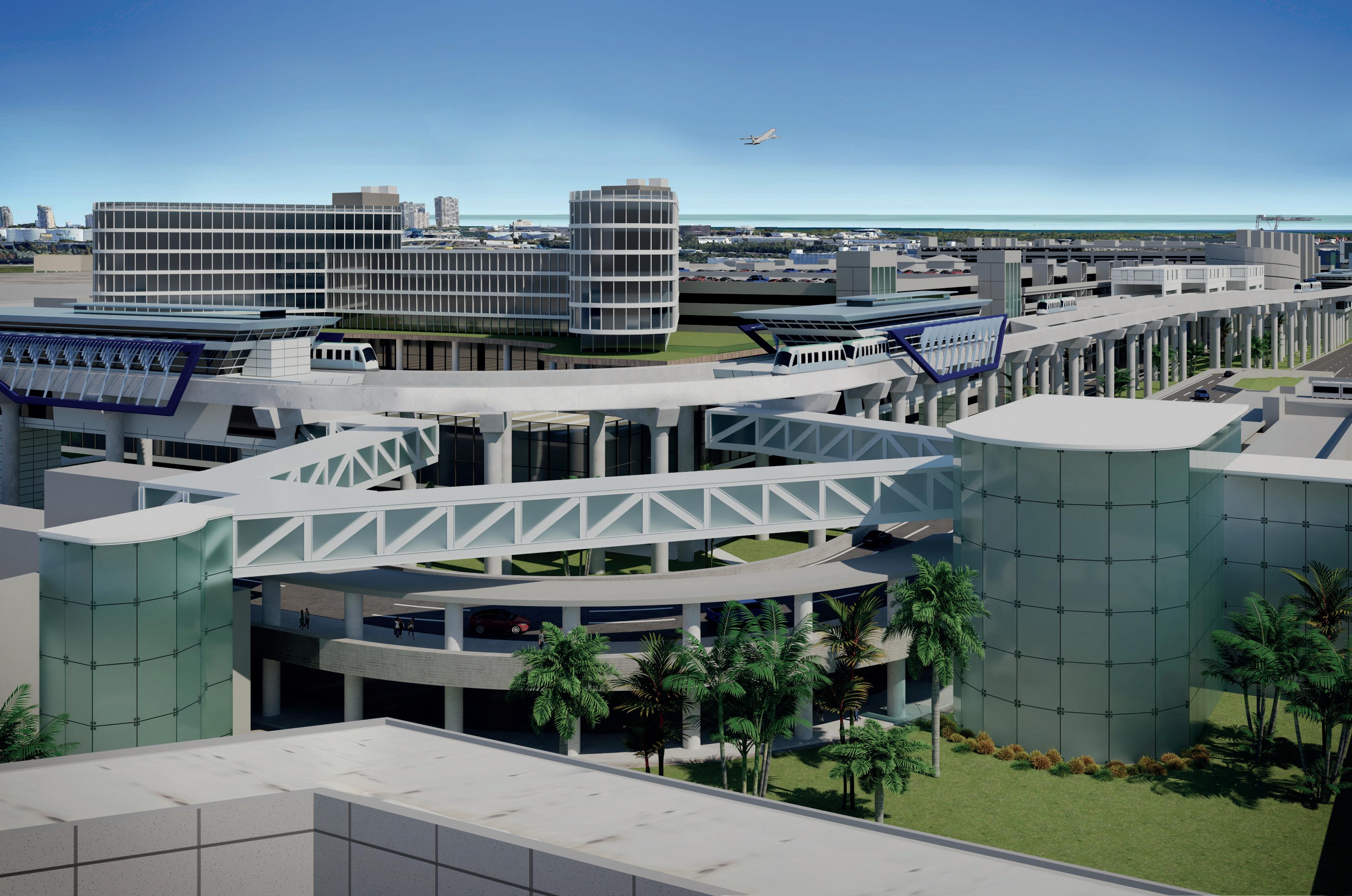
Big ambitions at Fort Lauderdale International Airport Fort Lauderdale-Hollywood International Airport (FLL) has started preliminary work on Terminal 5, its first new-build terminal in decades, has plans for a new Automated People Mover (APM) and Intermodal Center, and is adding some “game changing” terminal connectors post security.
Expected to handle around five million passengers annually, Terminal 5 is designed as a two-level, five-gate domestic terminal with check-in/ticketing areas, arrival/departure baggage processing, a security screening checkpoint, and retail/food and beverage concessions.
The estimated $404 million state-of-the-art facility will connect to the existing onsite Cypress parking garage and Terminal 4 through multi-level pedestrian bridges/walkways.
It will have Americans with Disabilities Act (ADA) features similar to the existing terminals and will have environmentally friendly elements built to Leadership in Energy and Environmental Design or LEED Silver certification standards.
"We're excited about FLL's new terminal and expect it's going to be a welcome and much-needed asset to accommodate our airport's growth," says Broward County administrator, Monica Cepero.
Preliminary work on the approximately 230,000-square-foot terminal set to rise on the east side of Terminal 4 has commenced with site clearing and tree mitigation, among other early-phase tasks. Construction should take about three years for a targeted completion in mid-2026.
"The new terminal will help provide the needed critical infrastructure required to propel FLL forward by creating opportunities for new and existing airline partners to grow and help set the stage for future Master Plan expansion activities," enthuses FLL’s CEO/director of aviation, Mark Gale.
Based on a joint agreement between Broward County and JetBlue Airways Corp, the New York-based carrier is managing the construction of FLL's new terminal on behalf of the County. JetBlue, FLL's secondlargest airline, also oversaw the modernisation project in Terminal 3, where the carrier primarily operates.
Firms working on the project include Parsons, M Arthur Gensler & Associates, KEITH and Hunt/Moss.
In another project, Broward County Aviation Department (BCAD) has received a $50 million grant from the FAA to fund a portion of FLL's Terminal Connectors project, which consists of the construction of enclosed post-security walkways between Terminals 1 and 2 and Terminals 2 and 3.
The project also includes modifications to the existing terminals, such as enhanced security checkpoints, an upgraded baggage hall, an expanded passenger gate-area holdroom, and more retail and F&B concessions.
According to the latest plans, the Terminal Connectors project is expected to cost around $260 million, with work targeted for completion in late 2027.
"The two new terminal connectors will be game changers for FLL," noted Gale. "When completed, all airport terminals will be connected post-security, enabling passengers to move freely throughout the secured areas without exiting and re-entering a security checkpoint."
Other projects in the pipeline include an $835 million Intermodal Center (IMC), which it expects to start construction on within three to five years, and a new APM within the next decade.
As currently proposed, the APM circulator at FLL would consist of an elevated (60-65 feet above ground level) guideway and train system connecting the airport’s terminals, existing parking garages, Rental Car Center, and the future Intermodal Center in a closed loop with up to six stations and a Maintenance and Storage Facility.
24 SPECIAL REPORT: MASTER PLANNING & DESIGN AIRPORT WORLD/ISSUE 2, 2024




































Find out more on smart-airports.com/sar HOST 10 - 12 July 2024 | Denver, Colorado, USA 9TH ANNUAL SMART AIRPORTS & REGIONS CONFERENCE & EXHIBITION Gold & Pre-Conference Workshop Sponsor Gold Sponsor Gold Sponsor Gold Sponsor Gold Sponsor Gold Sponsor Gold Sponsor Media Partner Media Partner Media Partner Media Partner Media Partner Media Partner Refreshment Break Sponsor Diamond Sponsor Platinum Sponsor Ribbon Cutting & WIFi Sponsors Affiliate Partner IAP CoP 2024 Forum Platinum Sponsor Silver Sponsor Silver Sponsor Silver Sponsor SMART Sponsor Refreshment Break Sponsor SMART Sponsor Silver Sponsor Gold Sponsor Gold Sponsor Gold Sponsor Lanyard Sponsor Silver Sponsor Silver Sponsor Silver Sponsor Refreshment Break Sponsor

Long Than International Airport
Vietnam’s planned new Long Thanh International Airport promises to be one of the most modern, innovative and exciting gateways in Asia-Pacific.
The country’s much-awaited new international airport is being built in Long Thành, Dong Nai Province, around 40 kilometres east of Ho Chi Minh City.
Phase 1 of the new greenfield gateway is due to be completed in the first half of 2026, at which time it will be equipped with a 25 million passengers per annum capacity terminal building, single 4,000-metre runway, and cargo facilities capable of handling 1.2 million tonnes of cargo yearly.
However, with traffic soaring, the Airports Corporation of Vietnam (ACV) is already planning to build a second runway for the Long Thanh International Airport directly after the first runway becomes operational.
For this, ACV will utilise an estimated VND4 trillion ($162 million) saved from the first phase of the airport project.
And by the mid-2030s, two more runways and three more terminals will be added taking the total cost of the new airport to in excess of $18.7 billion. By this time, the airport will have a total capacity of 80-100 million passengers and five million tonnes of cargo annually.
The design of Long Thanh International Airport’s passenger terminal is said to have been inspired by the elegance of full-blossomed lotus petals, delicately embodied to complete the curvilinear shape of the terminal.
The design team wanted to embrace the unique characteristics of Vietnamese culture in its design and chose the lotus flower as it is viewed as a source of inspiration because it signifies strength.
The passenger terminal will occupy a total floor area of 400,000 square-metres spread over four floors that include separate Arrivals and Departures levels and a dedicated floor for baggage make-up.
While a ground transportation centre and short-term parking will be conveniently located in front of the terminal to ensure quick and easy connections for passengers and visitors.
In the meantime, such is the demand for air travel in Vietnam that the existing airport in Ho Chi Minh City is also being developed. A new Terminal 3 is currently being built at Tan Son Nhat International Airport and expected to open in April 2025, after which the airport will focus on expanding the existing Terminals 1 and 2.
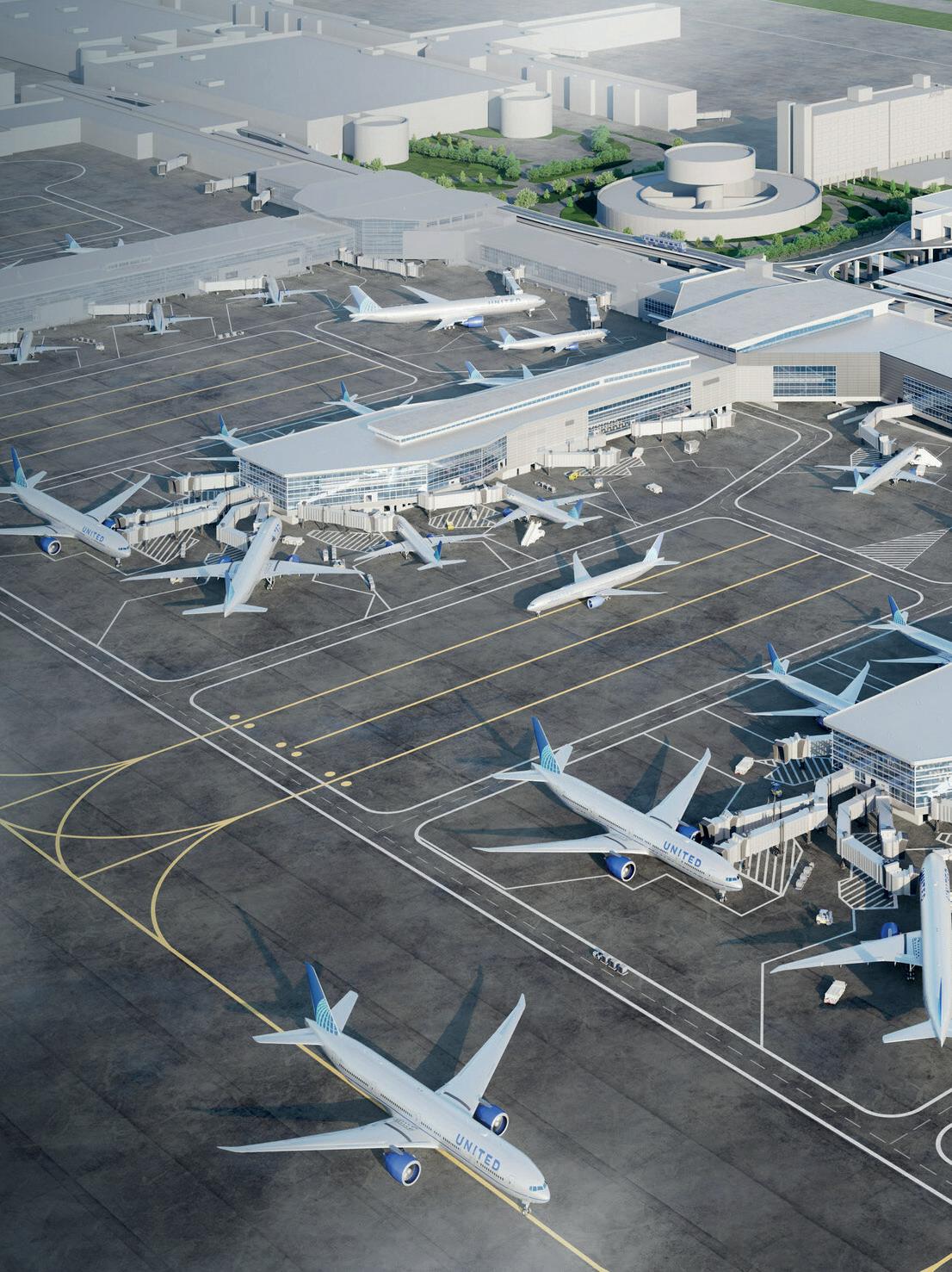
The future development programme at Tan Son Nhat is expected to cost $1 billion and will raise capacity from 46 to 76 million passengers per annum.
Planning next stage in development of Madinah Airport
TAV Airports is to invest $275 million on expanding the existing terminal and building a new domestic terminal at Madinah Airport (Medina) in Saudi Arabia.
It says that the investment is needed to ensure that the airport is equipped to handle 18 million passengers per annum, allowing it to meet “surging passenger traffic”, which last year jumped by just under 50% to 9.4 million passengers.
The gateway, officially called Prince Mohammad Bin Abdulaziz International Airport, was Saudi Arabia’s first airport privatisation project.
The signing of the ‘Head of Terms’ agreement was attended by the Saudi Arabia’s Minister of Transport Saleh bin Nasser AI Jasser; president of General Authority of Civil Aviation (GACA), Abdulaziz Al-Duailej;TAV Airports CEO, Serkan Kaptan, and executive board member and chair of excom, Franck Mereyde.
Kaptan enthused: “We have been successfully operating Madinah Airport, the gateway to the Holy Land, together with our partner Al-Rajhi, for the last 12 years. The passenger traffic is increasing on a very fast pace following lift of travel bans brought in during the pandemic.
“This new investment programme will help accommodate increasing demand and is fully supporting Saudi Arabia’s Vision 2030, which aims to attract more visitors into the country.”
The consortium of TAV Airports and Al-Rajhi Holding holds the concession rights to operate Madinah Airport until May 2041.
The planned investment includes building a new domestic terminal with an area of 40,000sqm, which allow for the existing terminal to concentrate on the further development of international traffic.
According to TAV Airports, which is a member of Groupe ADP, the airport will also benefit from new connecting roads and more car parking spaces.
TAV Airports began the operation and development of Madinah Airport in 2012 and has since built a new terminal, which upon opening was the first LEED-certificated building in the MENA region.
Global airport operator, TAV Airports, served 96 million passengers in 2023 at 110 airports in 33 countries across the globe.
26 SPECIAL REPORT: MASTER PLANNING & DESIGN AIRPORT WORLD/ISSUE 2, 2024
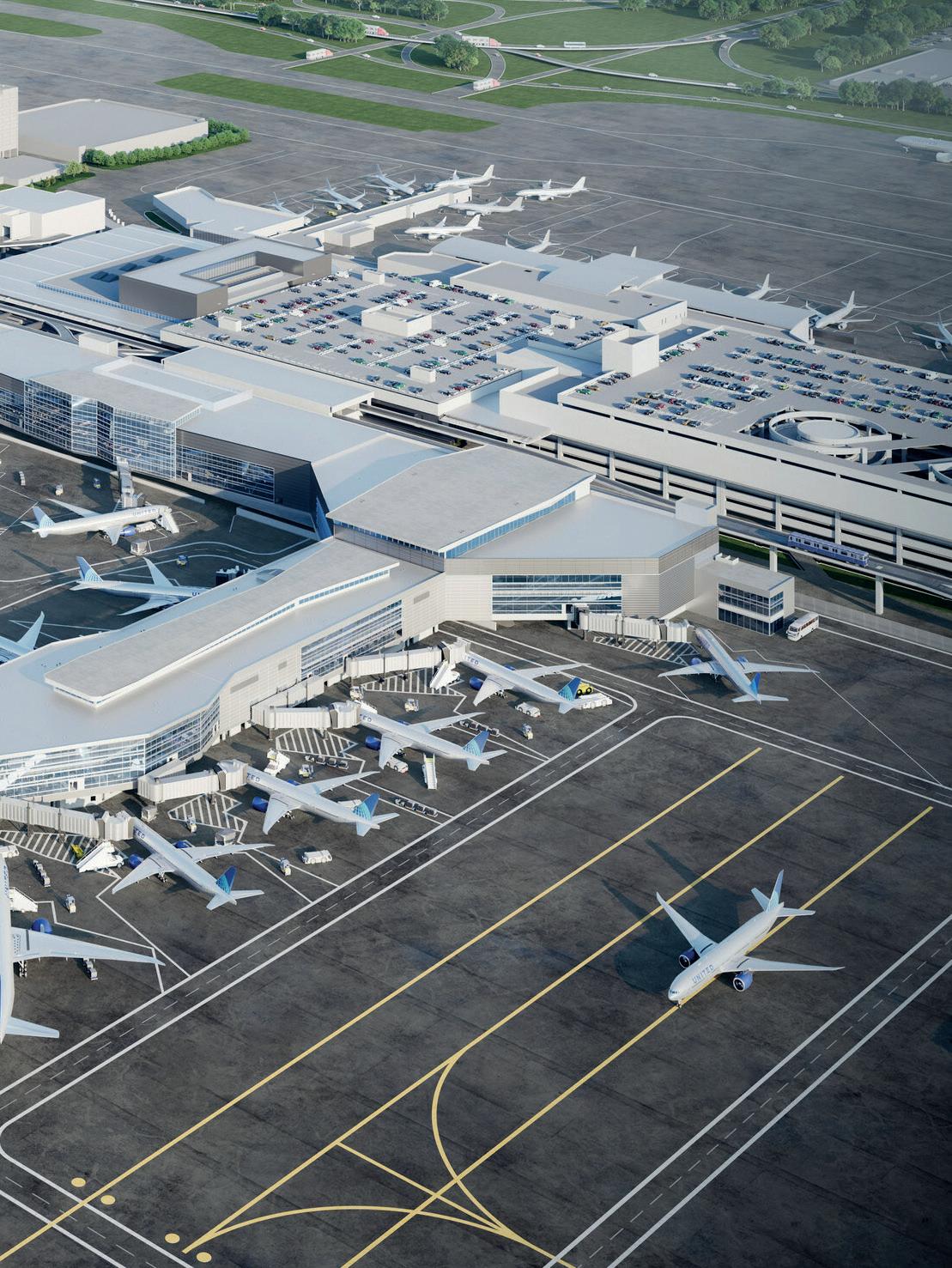

Terminal B Transformation Program at Houston Bush United Airlines and Houston Airport System (HAS) plan to “redefine the air travel experience and cater to the future needs of passengers” upon completion of the airline’s Terminal B Transformation Program at George Bush Intercontinental Airport (IAH).
The programme encompasses the construction of 40 new gates for both domestic and international travel, to ensure what is being described as a cutting-edge experience for up to 36 million passengers per annum. The Terminal B transformation includes expanding kerbside and roadway capacity, along with expanding the ticketing lobby, offering passengers convenience through dynamic signage, intuitive wayfinding systems and a ground-level check-in area. The third floor is expected to house a streamlined security processing area.
Once through security, the New Terminal B North expansion comprises two new passenger concourses, replacing the 1969-era Flight Stations. The Terminal B North Concourse, spanning approximately 765,000 square feet over three levels, will house 22 narrow-body gates.
Additionally, a large United ClubSM at the mezzanine level will offer unobstructed views of the airfield, set to become the largest club in the United system.
The project will also include two major concessions hubs, offering 115,000 square feet of state-of-the-art food and retail space including unique dining and shopping experiences.
The baggage claim hall will be expanded, and a new baggage handling system, equipped with advanced baggage tracking technology, will support increased capacity.
"The expansion of Terminal B underscores the shared commitment between United Airlines and the City of Houston to enhance Bush Airport and Houston's economy," said Houston mayor, Sylvester Turner.
"This redevelopment programme will bring nearly 3,000 new jobs to Houston. The bigger and more modern domestic terminal will amplify Houston's reputation as a premier destination and cultivate even more opportunities for future economic development.”
United Airlines is to invest close to $2 billion in the Terminal B Transformation Program and the City of Houston expects to fund $624 million in enabling projects required for the programme.
Construction and design companies involved in the project include Page; Grimshaw Architects; Clark Construction; and PGAL, a
Houston-based international design firm specialising in architecture, interiors, engineering.
New terminal opens at Tiruchirappalli International Airport Tiruchirappalli International Airport’s new integrated passenger terminal designed by Pascall+Watson Architects has been officially inaugurated by India’s Prime Minister, Narendra Modi.
Spanning an impressive 75,000 square metres, the 4.5 million passenger capacity building is said to reflect the city's vibrant heritage while embracing sustainability and future development.
Indeed, embracing renewable energy measures and innovative initiatives such as rainwater harvesting systems, ground-source heat pumps, and photovoltaic panels helped the terminal achieve GRIHA Four Star rating, ensuring that sustainability is at its heart.
Other ‘green’ measures include the use of energy-efficient canopies and LED lighting, low heat gain double glazing units and extensive landscaping featuring native flora.
According to Pascall+Watson, other notable design highlights include an “expressive roof form and multi-layered facade, showcasing geometry, textures, and colours that reflect the city's traditional style”.
Describing its design concepts for the Tamil Nadu located airport’s new terminal, Pascall+Watson says that it drew inspiration from Tiruchirappalli’s rich architectural heritage and local customs, noting that it “successfully infused age-old temple architecture elements to create a distinctive identity for the airport”.
Nitesh Naidoo, director for Pascall+Watson, said: “We are delighted to have been given the opportunity to develop the vision for the New Terminal, a bold and inspired design approach that truly speaks of its time and place.”
In fact Pascall+Watson believes that the Tiruchirappalli International Airport project serves as an embodiment of blending cultural significance with advanced architectural solutions.
“The intelligent use of traditional inspiration alongside modern materials elevates its status as a powerful symbol for the state of Tamil Nadu,” states the global design company.
Egis India was engaged as design and project management consultant for the construction of the new terminal building, elevated roads and all other associated work.
27 AIRPORT WORLD/ISSUE 2, 2024
SPECIAL REPORT: MASTER PLANNING & DESIGN
Terminal B Transformation Program at Houston George Bush Intercontinental Airport. Tiruchirappalli's new terminal.
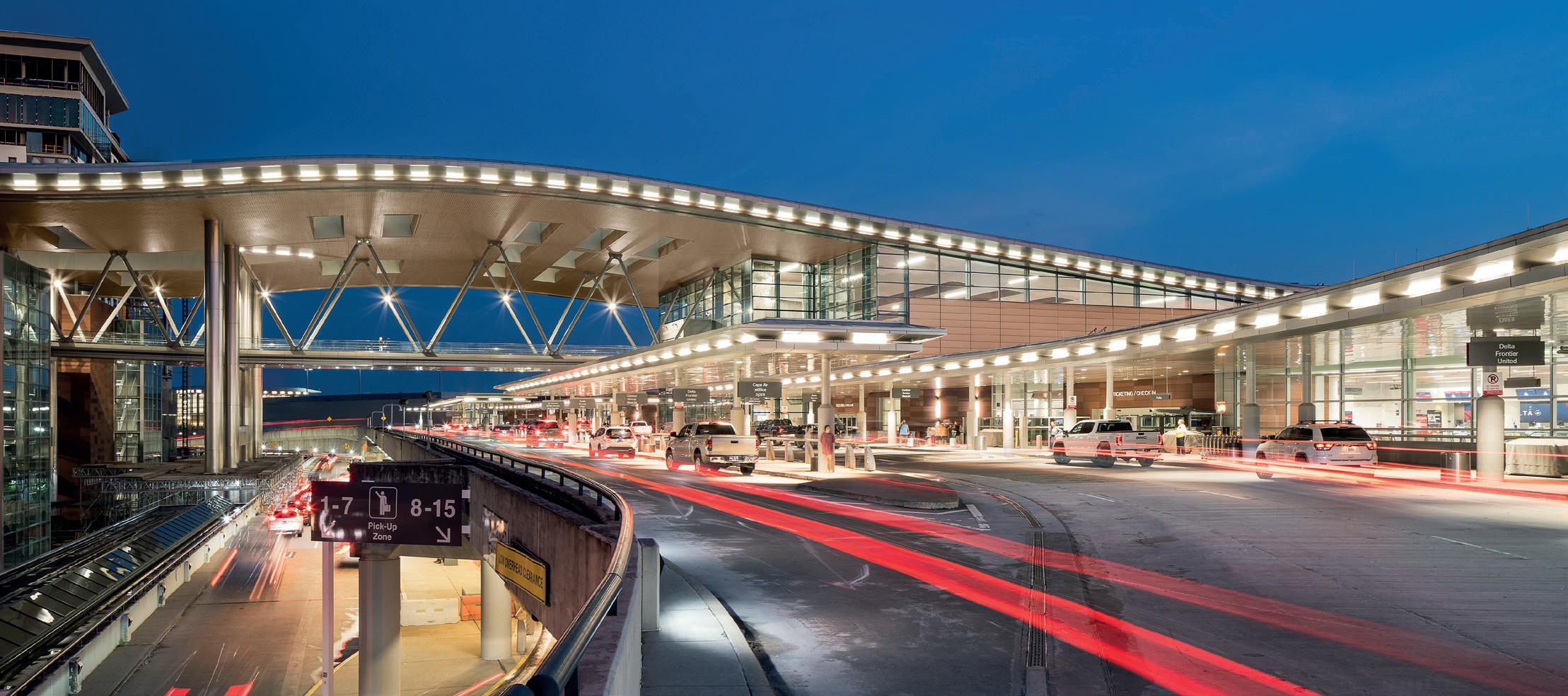
Strategic planning
Nashville International Airport (BNA) soared to new heights in 2023, welcoming a record-breaking 21.9 million passengers, a remarkable 18.7% increase from 2022.
This surge in traffic, propelled by the visionary BNA Vision initiative launched in 2017, prompted Fentress Architects to embark on a series of transformative projects aimed at accommodating the escalating passenger volumes.
Under the leadership of Curtis Fentress, FAIA Principal in Charge of Design, Fentress Architects commenced their collaboration with BNA in 2017, initiating a portfolio of projects designed to enhance the airport's infrastructure:
• Concourse D and Terminal Wings (opened July 2020)
• Terminal Lobby (opened January 2023)
• International Arrivals Facility (opened September 2023)
• Concourse D Extension (scheduled for 2025)
• Concourse A (scheduled for 2028)
The Terminal Lobby, unveiled in January 2023, boasts a waved roof canopy extending seamlessly from the terminal garage to the International Arrivals Facility (IAF).
This innovative canopy provides coverage for roadway and kerbside access, significantly improving passenger convenience. Moreover, the central core vertically connects all five levels, optimising spatial organisation and enhancing passenger flow throughout the airport.
Sustainability remains a cornerstone of Fentress Architects' approach at BNA. With a focus on achieving a minimum of USGBC LEED Silver Certification for all facilities, each new space incorporates features such as electrochromic glass to optimise energy use, ensuring BNA's growth is both incorporative of technical innovation and is environmentally responsible.
The International Arrivals Facility, inaugurated in September 2023, addresses the escalating demand from Europe, Asia, and Latin America.
With six international gates, automated passport controls, and a central concession marketplace, it ensures a seamless and enjoyable experience for passengers arriving from abroad.
Fentress Architects are currently engaged in the expansion of Concourse D, slated for completion in 2025. This extension will introduce five additional gates and outdoor spaces, offering passengers panoramic views of the airfield. Additionally, the new space will incorporate symbolic elements reflective of Nashville's musical heritage.
Furthering the airport's development, Concourse A is also being replaced and scheduled for completion in 2028. It will add 16 new gates, approximately 380,000 square feet, and enhance the North Terminal with expanded ticketing and baggage claim halls.
This addition represents BNA's commitment to accommodating future growth of a 59.77% increase from 21.9 million passengers in 2023 to 35 million passengers by 2028.
 and design at Nashville Airport
and design at Nashville Airport
28 SPECIAL REPORT: MASTER PLANNING & DESIGN AIRPORT WORLD/ISSUE 2, 2024 AW






































10 - 12 July 2024 | Denver, Colorado, USA INTERESTED IN SPONSORSHIP OR EXHIBITING? CONTACT: ANDREW HAZELL COMMERCIAL DIRECTOR E: andrew@smartairports.aero T: +44 (0)7495 611 215 28 29 39 38 30 31 37 36 23 26 15 16 13 14 11 12 9 10 7 8 5 6 4 17 1 2 3 32 33 35 34 19 20 18 21 22 27 24 25 40 41 51 50 42 43 49 48 44 45 47 46 2a 2b 1b 1a 1d 1c 25b 25a 27b 27a Sold Booth Refreshments Available Booth F&B F&B F&B REGISTRATION CONFERENCE ROOM
ANNUAL
AIRPORTS & REGIONS CONFERENCE & EXHIBITION EXHIBITORS
9TH
SMART

On the menu
Michael Murphy-Pyle, head of media at Manchester Airport, tells us more about the sense of place strategy behind the ongoing transformation of the gateway’s retail offerings.
Manchester in the UK has always had a very clear sense of its own identity. Its culture, history, architecture, and attitude are all unique and things that its people are rightly proud of.
At Manchester Airport we are proud to serve the people of the North as a whole with more flights to more destinations than any airport outside of London. But we never want to lose sight of the fact that we are in Manchester and of Manchester.
Some aspects of international travel are necessarily uniform. Familiarity and predictability are, to some extent, necessary in travel hubs to help ease the stress of travel.
But, at the same time, we don’t want people to lose sight of the fact that they are in Manchester. That’s why a key element of the £1.3bn Manchester Airport Transformation Programme (MAN-TP) has been a focus on identity and a sense of place.
The programme itself centres on our Terminal 2. It was announced in 2015 and is revolutionising both the passenger and colleague experience at the airport. It involves doubling the capacity of Terminal 2 so that it can accommodate 70% of the airport’s passengers.
The first phase of the project was an extension of the existing facility which opened in 2021 and the second phase is the redevelopment of old part of the terminal so that it matches the new part.
The new part of the terminal has already been awarded the prestigious, UNESCO-backed Prix Versailles for its architecture and
design and, once complete, the whole project will provide everyone who uses the airport with an experience that is in line with the very best airports around the world.
The retail offer is a key part of what we’re doing through MAN-TP. In Terminal 2 now, you’ll find all the things you expect in a major international airport; high-end duty free, recognisable high street brands and familiar food and drink names.
But you’ll also find several of Manchester’s favourite local brands plus a focus on regional produce and products. And that hasn’t happened by accident.
In tendering for the outlets that are already in the International Departure Lounge we placed significant value on provenance.
The result is that alongside those brands that will be familiar to you wherever you’re from, are brands that Mancunians and Northerners know and love.
As you arrive in Terminal 2’s International Departure Lounge and pass through duty free three of the first things you see – set against a huge honeycomb light installation that is a reference to Manchester’s famous bee icon – are local favourite Italian restaurant San Carlo flanked by bars operated by Manchester-based brewers Seven Bro7ers and Joseph Holt.
Both outlets – Seven Bro7ers’ Amber Alehouse and Joseph Holt’s Bridgewater Exchange – have their own microbreweries meaning you can drink some of Manchester’s finest beers just a few feet from where they’ve been brewed.
30 SPECIAL REPORT: MASTER PLANNING & DESIGN AIRPORT WORLD/ISSUE 2, 2024

Around the corner you’ll find Archie’s, the incredibly Instagrammable and Manchester-based burger joint as well as Pot Kettle Black, another local chain specialising in quality coffee and café type food.
Between them, these brands mean that if you’re from the area travelling away on holiday or on business you can visit brands you know and love and have a real affinity with.
It also means that if you’re not from the area and you’re maybe travelling back from a UK holiday, you’ll be exposed to some of Manchester and the North’s own brands, meaning greater exposure for them and money into the regional economy.
We’re continuing that work as we look to fill the units in the side of Terminal 2 that is currently in development and will open next year. There are a total of 27 units that we’re looking to fill with a range of retail and food and beverage.
In the tendering process for these units we’ve stuck to the ethos that led the first phase; by keeping a focus on locally based outlets and those that favour local produce and products.
Although we’re not in a position to reveal the names of the retailers and food and beverage outlets quite yet, we can say that not only will there be more local names alongside some stellar national and international brands, we’re also going to be introducing a ‘market hall’ style concept.
Like many cities and towns around the country, Manchester is home to a growing number of market hall style offerings where a group of different outlets will be based around a central area allowing groups of customers to eat from different places while still sitting together.
They provide a great platform for smaller, locally based retailers to operate and we’re looking forward to implementing the concept.
Ultimately all this work on maintaining a local focus provides a range of advantages and upsides. It means Manchester Airport will always feel like Manchester’s airport, which is important to us, it means our passengers see the brands they have real connections with and it gives those brands international exposure.
Mark Flanagan, the owner of Pot Kettle Black, recently talked to us about the effect having an airport branch has had on his business.
He said that from opening 10 years ago in a small premises in Manchester’s Barton Arcade, their expansion and the opening of the airport branch has led to international visitors going to their city centre branches because they’ve been to the one in the airport.
In a nutshell, this is the kind of thing we’re trying to achieve through our retail and food and beverage strategy.
As an airport our priority is serving the people of the North. This doesn’t just mean getting passengers to the places they want to go to and giving them a great experience as they do it meaning they can start their holiday here, it also means helping local businesses to thrive where we can.
We plan to continue with this strategy as we move forward and will carry on looking to work with innovative, exciting and regionally based brands at every opportunity.
31 SPECIAL REPORT: MASTER PLANNING & DESIGN AIRPORT WORLD/ISSUE 2, 2024 AW
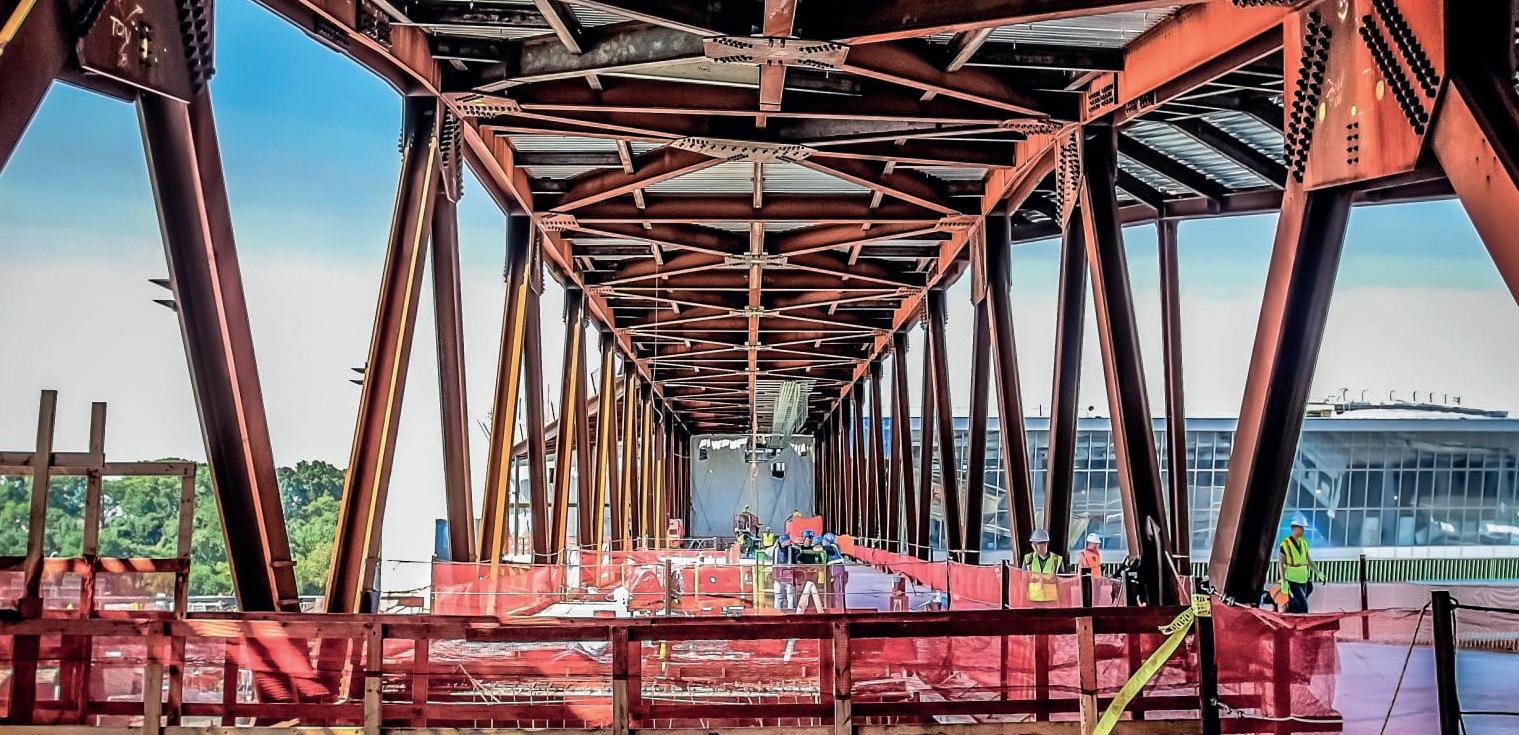
All systems go!
With traffic levels hitting new highs, an ever increasing number of US airports are investing in new infrastructure and technology to avoid a potential capacity crunch in the near future, writes Mary Scott Nabers.
Following a near-total collapse of air travel during the COVID-19 pandemic, early 2024 marks a significant milestone as North American air travel is finally returning to normal.
Normal, however, may not be the appropriate word because many airports are experiencing significantly higher passenger demand. The demand is driving a significant need for expansion and renovation, resulting in an abundance of new airport projects.
The Bipartisan Infrastructure Law provided $15 billion for all kinds of airport projects. This funding has been streaming out since 2022 at a rate of about $2.9 billion per year. And the outflow will continue until 2026.
To date, approximately $9 billion has been made available to airports, and about $6 billion is left to be allocated.
Airports big and small are feeling the pressure to grow their infrastructure. One such gateway is Pensacola Airport in Florida, which has experienced a 40% increase in passengers, creating an immediate need to expand its terminals to accommodate the growth.
Funded partially by the Florida Department of Transportation, a new $70 million project to expand the existing terminal’s capacity by about 50% will begin soon.
While the design process is still underway, the expansion is expected to include larger security spaces, a second concourse with five new gates and numerous new concessions. Plans also call for additional parking spaces and improving utility infrastructure throughout the airport.
Elsewhere, in Ohio, officials at the Cleveland Hopkins International Airport will soon launch a massive expansion project to the facility’s main terminal and concourses.
Funded through grants from the Federal Aviation Administration (FAA) and non-aviation-related revenues, phase one of this project is
expected to be the most significant phase in construction, and it carries a cost projection of $780 million.
It will expand the main terminal building to include new spaces for ticketing, customs, baggage claims and security. It will also relocate the existing car rental building and add additional parking.
Later phases of the project will reroute the airport’s surrounding roadways. The design phase may be ongoing through 2025, and if that is the case, construction will potentially begin in late 2025.
Meanwhile in Connecticut, Tweed New Haven Airport executives recently received federal approval to move forward with plans to expand the airport runway and build a new 70,000-square-foot terminal and airport entrance.
The $165 million expansion will increase the airport’s capacity, keep up with regulatory requirements and reduce noise pollution from increased air traffic. According to planning documents, phase one of the project will include a $74 million cost for land acquisition, obstruction removal, design work and then construction of the new terminal.
Also included will be runway extension and noise mitigation. Other project components include more land acquisition, expansion of a maintenance building and fuel farm, a taxiway expansion, and the construction of additional hangars. A construction launch may be delayed until 2026.
While most airport projects involve construction and expansion, technological improvements will almost always be required to increase the efficiency of airport processes.
Orlando International Airport, for example, is looking to identify a partner to install an Automated Parking Guidance System to enhance the operational efficiency and ease of use of its huge car parking operation, which boasts 22,000 parking spaces across numerous parking garages and surface lots.
32 SPECIAL REPORT: MASTER PLANNING & DESIGN AIRPORT WORLD/ISSUE 2, 2024
A newly launched request for proposals asks bidders to provide software, hardware, equipment, installation and seven years of support and maintenance for the system, which is expected to cost around $10 million.
The new parking system will monitor vacant spaces in real time, provide coloured indicators to indicate full and empty spaces and deliver parking information on roadway signage and online applications.
Another large project worthy of note can be found at the AustinBergstrom International Airport where the Texas gateway is looking to build a new concourse to raise its capacity to accommodate increasing demand for air travel in Central Texas.
The Concourse B project will deliver a 20-gate concourse with passenger and tenant spaces, state-of-the-art passenger boarding bridges, an expanded baggage handling system and improved apron support spaces.
Additionally, it will feature extensive underground utilities, including an in-pavement hydrant fuelling system. The project will also include constructing a new sub-grade tunnel to connect the Barbara Jordan Terminal with the new Concourse B facility.
The design will provide the capability to expand to a new Concourse C when the time is right. The tunnel project will likely include an Automated People Mover corridor.
With a towering projected cost between $1.1 billion and $2 billion, the Concourse B and tunnel project is scheduled for completion in 2030.
Expanding our lens to the wider scope of North American aviation, notable developments are underway at Los Angeles International Airport (LAX), one of the busiest airports in the world.
With a staggering budget of $14 billion, designers will plan to enhance the passenger experience and increase operational efficiency. Plans include the revitalisation of the international terminal, upgraded amenities and improved transportation infrastructure to alleviate traffic congestion around the airport (See page 34 of this issue for more details)
Similarly, Houston Intercontinental Airport (IAH) is establishing an innovation hub to foster collaboration between airport stakeholders, technology companies and start-ups. This hub will focus on developing cutting-edge solutions to enhance passenger safety, streamline operations and improve the overall travel experience. This initiative reflects IAH's commitment to embracing innovation and leveraging technology to meet evolving industry needs.
Terminal A, one of the two original terminals at IAH since 1969, will undergo a significant upgrade. The FAA funding allows for the
implementation of sustainable and modern design elements, ensuring a comfortable and state-of-the-art restroom experience for passengers.
Additionally, the funding will contribute to the ongoing revitalisation efforts in Terminal D. Recent construction projects in Terminal D include the replacement of flooring, furniture and lighting, along with new paint to create a more modern and aesthetically pleasing environment for travellers.
The United States Department of Transportation (USDOT) has allocated a total of $970 million in Airport Terminal Program (ATP) funding to 114 airports across the country. This includes $10.4 million designated for widening the arrivals terminal access road by two lanes at Seattle-Tacoma International Airport (SEA) and $2 million for various upgrades and improvements at Spokane International Airport to enhance passenger experience and accessibility.
In addition, SEA is implementing sustainability initiatives as part of its expansion efforts. These initiatives aim to reduce the airport's carbon footprint by incorporating renewable energy sources, improving recycling programmes, and promoting the use of electric vehicles. These efforts align with the airport's commitment to environmental stewardship and responsible growth.
Furthermore, the DOT has invested approximately $225.6 million in Washington state airports to modernise airport infrastructure, with $82.565 million allocated through the ATP since 2022.
Federally funded airport projects will continue to launch through 2026. Many more are currently in the planning stages.
The expansion era of North American air travel promises to usher in a new chapter of prosperity, connectivity and sustainability for the aviation industry. As airports adapt to the evolving landscape of post-pandemic travel, strategic investments in infrastructure, technology and sustainability will play a pivotal role in shaping the future of air travel.
With collaboration and innovation at the forefront, airports are poised to meet the challenges and opportunities of the post-pandemic era, ensuring a seamless and sustainable travel experience for passengers worldwide.
About the author
Having written two books on infrastructure, Mary Scott Nabers –the president and CEO of Strategic Partnerships, Inc – is recognised as an expert on public private partnerships.
33 AIRPORT WORLD/ISSUE 2, 2024
AW SPECIAL REPORT: MASTER PLANNING & DESIGN
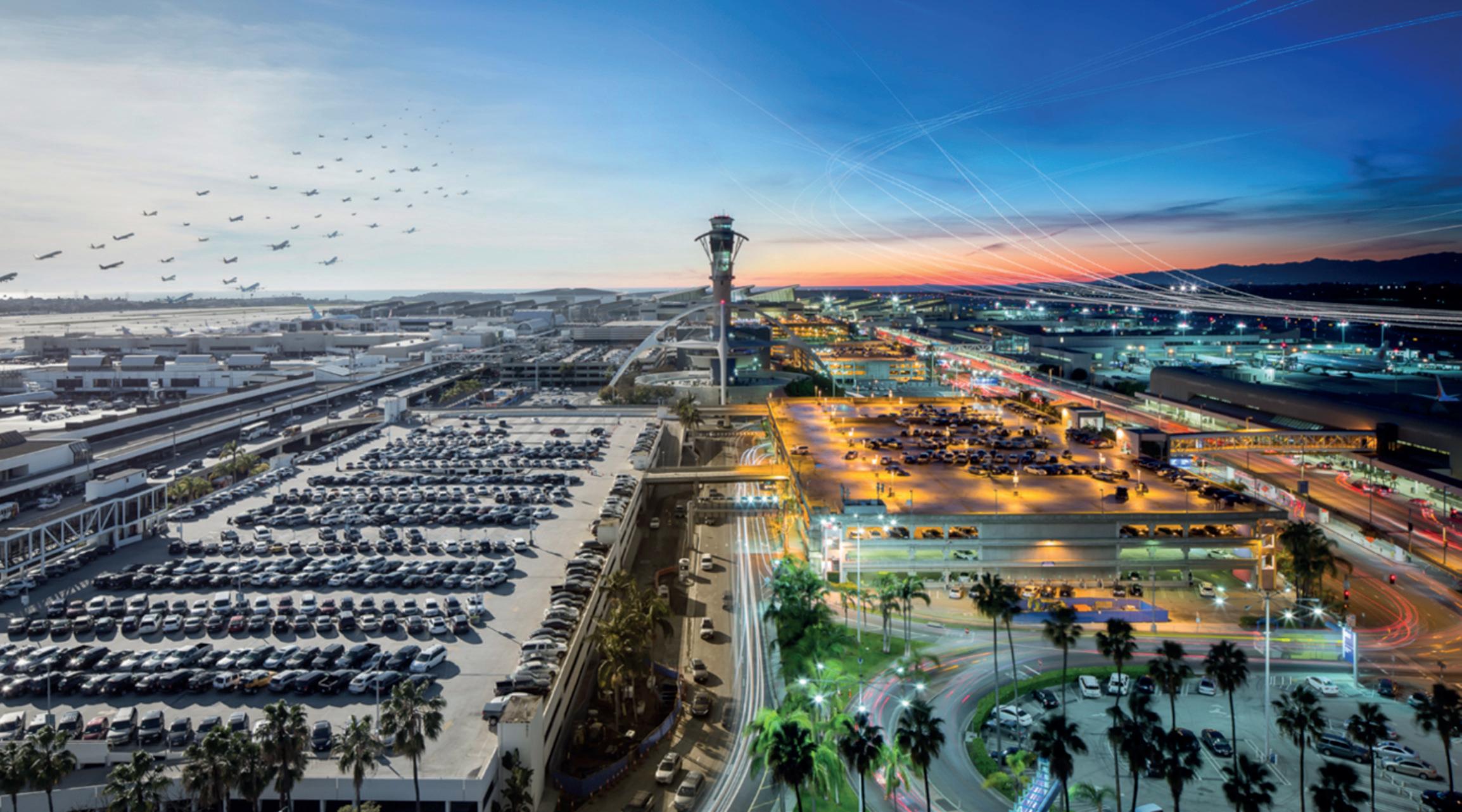
LAX story
Justin Wortman and Jon Phillips update us on the role HOK and Arup are playing in the ongoing upgrade of Los Angeles International Airport.
Los Angeles World Airports (LAWA) is in the midst of a $30 billion transformation centred around elevating guests’ experiences through efficiency, thoughtful design and unexpected delights.
This comprehensive modernisation is underway in advance of Los Angeles International Airport (LAX) and the City of LA welcoming guests from across the US and the world to an exciting collection of events, including the Olympic and Paralympic Games in 2028.
While these improvements ensure best-in-class offerings for global and national sports spectators, they will also provide incredible guest journeys for generations to come.
To realise its ambitions, LAWA is partnering with architecture, design and engineering firms that share its vision of creating a transformed LAX and positive guest experiences from start to finish.
One collaboration that is yielding important projects and approaches is LAWA’s work with HOK+Arup, a joint venture team comprised of members from each firm’s local studios. Together, LAWA and HOK+Arup are working to reimagine LAX.
Campus optimisation and improvements
In line with the transformation at LAX, multiple airside shifts at the airport have taken place in recent years. United Airlines moved its facilities to the east end of the airport campus, Delta moved to the north side of the Central Terminal Area with the modernisation of Terminals 2 and 3, Concourse 0 is under development, and the Security Badging Office and Airport Police Facility were relocated to different sections of the airport campus.
Based on these moves, LAWA determined there were opportunities to optimise over 100 acres of LAX property. The HOK+Arup team is working with LAWA to determine how to leverage that property for the future.
The project team completed a multi-disciplinary study of potential improvements across various terminals, landside elements and roadways at LAX. The study aims to help LAWA balance its short and long-term needs at the airport. This supported LAWA in understanding project phasing options for the campus that would help mitigate construction impacts on operations.
One aspect of these campus optimisations focused on commercial redevelopment opportunities. HOK+Arup engaged commercial space planning consultant, Pragma, to develop a concessions performance analysis at LAX, which included market research and a foot traffic analysis at the airport.
Based on this research, HOK+Arup identified opportunities for the commercial programme and increasing non-aeronautical revenues at the airport.
The project team also provided design options for the look and feel of potential commercial spaces, ensuring they would flow with the surrounding terminal area’s interior design.
The team analysed base building systems around these potential concessions spaces to determine if any upgrades were needed, covering everything from sprinkler systems and lighting to HVAC systems. This work will help LAWA provide clarity around concessions lease arrangements in the future.
34 SPECIAL REPORT: MASTER PLANNING & DESIGN AIRPORT WORLD/ISSUE 2, 2024 Image courtesy Los Angeles World Airports.
Passenger journey mapping
Understanding how passengers move through and interact with an airport can inform design and improve operation decision-making.
To help create a more seamless experience for travellers, HOK+Arup led a passenger journey mapping initiative that analysed how different passengers might interact with airport terminals.
HOK+Arup, working with sub-consultants UNStudio and Faith Group, investigated various passenger ‘personas’ and their possible journeys from Terminal 1 and the Tom Bradley International Terminal.
The study sought to answer critical questions, like how an experienced business traveller might interact with the space, and what considerations should be accounted for when designing for families travelling with children.
The analysis, which included a survey of 367 passenger volunteers, focused on emotional responses, sentiments and perspectives on the various segments of their journeys.
Technological devices called iMotions were affixed to the volunteers to monitor their physical reactions. Data collected included galvanic skin response (indicating activation of sweat glands), heart rate, gaze fixations and saccades (rapid eye movement).
The biometric information collected provided a detailed level of analysis of a given passenger’s response to their environment throughout their journey through the terminals. The personal data collection was complemented by video footage from static cameras, which tracked movement to generate heat maps and trajectory lines.
The team used the results of the analysis and mapping to build typologies of different passenger needs and priorities, helping LAWA further understand and classify passenger journey requirements.
Modernising terminals
Passenger journey mapping is also helping to inform possible modernisations to kerbside spaces, ticketing halls, security processing, domestic arrival spaces and concourses to terminals at LAX.
HOK+Arup are collaborating with LAWA to strategically identify cost-effective interventions that make spaces more welcoming for travellers.
“Our terminal modernisation recommendations are approached through the lens of enhancing the passenger experience,” said Anne Fletcher, AIA, LEED AP, HOK’s principal-in-charge and principal architect on LAWA projects.
“Our work with LAWA aims to streamline the passenger journey, ensuring that guests arrive, move through and depart LAX with ease.”
Recommendations include enhanced wayfinding and signage, improved lighting, refreshed finishes and opportunities to maximise natural light in the terminals. The team also investigated various base building system upgrades, including new lighting and mechanical systems, that would increase energy efficiency at LAX.
Additionally, HOK+Arup helped LAWA explore possibilities relating to the development and management of a digital assets portfolio to showcase relevant content on video boards throughout the airport.
These include screens that update travellers on plane departures and arrivals, security processing times and more.
To aid with this work, the team engaged integrated partner Faith Group to provide a benchmarking study for LAWA. The findings are creating a foundation upon which future decisions on digital asset management will be based.
Fostering diversity and mentoring the next generation Diversity, equity and inclusion are key to LAWA’s modernisation approach, and HOK+Arup joined forces with the client to ensure DEI is present throughout the team’s work.
“Working at LAWA, HOK+Arup have assembled an impressive group of 56 sub-consultants, acting together as a dynamic team to bring wide-ranging expertise from design, architecture, engineering and planning,” said Benjamin Anstiss, Arup project lead and associate principal based in the firm’s Los Angeles office.
“Through our multi-disciplinary approach to collaboration, our team is a major contributor to large-scale design and planning projects across the airport.”
To further the industry-leading DEI goals set by LAWA, the team led a dual mentorship programme that brought five mentees to the offices of HOK+Arup to gain on-the-job experience working for a major airport.
The 12-week programme was aimed at individuals reaching the end of their studies in the AEC industry.
To recruit Los Angeles–based students for the programme, HOK+Arup worked with diversity, equity and inclusion and public affairs partner The Robert Group to conduct outreach to local universities and professional organisations.
Through the recruitment process, the group explored proactive ways to increase the number of women and people of color pursuing professional careers in the industry.
The cohort worked across project management and operations initiatives during the mentorship program. During meetings and presentations with LAWA, the mentees were exposed to the skills and approaches needed to collaborate on large infrastructure projects.
The opportunity also gave participants exposure to working with the small, local and minority businesses that are part of the HOK+Arup team.
Of the programme, mentee Kaitelyn Haynes, said: “I not only gained a better understanding of the multidisciplinary collaboration that goes into aviation project management, but got an insight into how my skill sets and background bring a valuable perspective to these discussions and environments.”
Collaborating for positive change
As a prominent hub for national and global travellers, the collaborative efforts of LAWA and HOK+Arup are helping to create a reimagined LAX where efficiency, thoughtful design and unexpected delights elevate guests’ experiences.
Guided by strategic campus optimisation plans that are rooted in comprehensive studies and passenger journey mapping, LAX is on track to further passenger satisfaction and convenience.
Additionally, by prioritising diversity, equity and inclusion within the project team and through mentorship initiatives, LAWA and HOK+Arup are engaging in meaningful DEI initiatives and paving the way for the next generation.
As LAX readies itself to host prestigious sporting events, it embraces its role not only as a gateway to Los Angeles but as a destination in its own right.
About the authors
Justin Wortman is regional leader of aviation and transportation at HOK and Jon Phillips is a principal at Arup.
35 SPECIAL REPORT: MASTER PLANNING & DESIGN AIRPORT WORLD/ISSUE 2, 2024
AW


Outstanding effort!
Airports big and small across the world have been recognised for their customer experience excellence throughout 2023 in ACI World's annual Airport Service Quality (ASQ) Awards.
There are plenty of familiar names and a number of new ones honoured in the Airport Service Quality (ASQ) Awards for 2023, with the winning airports ranging from small domestic airports handling only a few hundred thousand passengers a year to megahubs welcoming in excess of 100 million passenger per annum.
The winners include Dakar Blaise Diagne (Senegal) and Marrakech (Morocco) in Africa; Beijing Daxing (China), Gimpo (South Korea) and Singapore Changi (Singapore) in Asia-Pacific; Rome Fiumicino (Italy) and Barcelona (Spain) in Europe; Quito (Ecuador) and Los Cabos (Mexico) in Latin America; Muscat (Oman) and Amman (Jordan) in the Middle East; and Toronto Pearson (Canada) and Hartsfield-Jackson Atlanta (USA) in North America.
As usual, the award categories included ‘Best Airport by Size and Region’ and ‘Best Airport at Arrivals Globally’ as well as the newly introduced categories of ‘Airport with the Most Dedicated Staff’, ‘Easiest Airport Journey’, ‘Most Enjoyable Airport’ and ‘Cleanest Airport’.
Worth noting is that in 2023 over half of the world’s travellers passed through an ASQ airport, underscoring the programme’s credibility and influence in shaping the standards for exceptional airport services.
In addition nine airports won ASQ Awards in all five departure categories – Casablanca Mohammed V International Airport (Africa); Sultan Hasanuddin International Airport and Yogyakarta International Airport (Asia-Pacific); Izmir Adnan Menderes Airport and Rome
Fiumicino (Europe); Guayaquil International Airport (Latin America); Salalah Airport (Middle East); and Greenville-Spartanburg and Gerald R Ford international airports (North America).
Also, eight airports have been inducted into the ACI World Director General’s Roll of Excellence – a recognition given to airports that have won multiple ASQ awards over a five-year period in the last 10 years.
The inductees are:
– Shenzen Bao’an International Airport
– Chandigarh Airport
– Casablanca Mohammed V International Airport
– Muscat International Airport
– Cincinnati/Northern Kentucky International Airport
– Sultan Mahmud Badaruddin II Airport
– Sultan Hasanuddin International Airport
– Zagreb International Airport
View full list of winning airports
ACI World director general, Luis Felipe de Oliveira, said: “We are delighted that in 2023 the ASQ programme surpassed 400 participating airports in a historical record – reflecting our members’ commitment to placing the passenger first. Likewise, we thank the guests that dedicated their precious time by providing feedback in close to 600,000 surveys.
ASQ AWARDS 36 AIRPORT WORLD/ISSUE 2, 2024


“The global growth of the programme underscores the trust placed in its scientific and live approach, making ASQ the go-to standard for airport customer experience assessment in the aviation industry.”
Best by Size and Region
In Africa, Casablanca Mohammed V International Airport (CMN) and Marrakech (RAK) were joint top in the 5-15mppa category; Blaise Diagne (DSS) in Senegal and SSR International Airport (MRU) in Mauritious once again couldn’t be separated in the 2-5mppa section; and it was a similar story for Tanzania’s Abeid Amani Karume (ZNA), Madagascar’s Ivato (TNR) and Kenya’s Moi (MBA) international airports in the Under 2mppa Award.
Speaking about the ASQ success of Zanzibar’s Abeid Amani Karume International Airport, director of aerodromes for Egis/SEGAP, Rob Williams, said: “This achievement celebrates our collective teamwork and our commitment to excellence in terms of customer experience. We are honoured to receive this recognition which raises the profile of Zanzibar Airport and the islands as a destination”.
The winners were also straightforward in the Middle East, where once again Salalah (SLL) in Oman, Queen Alia (AMM) in Amman, Jordan, and Oman's Muscat International Airport (MCT) won the Under 2mppa, 5-15mppa and 15-25mppa categories respectively.
Reflecting on Queen Alia International Airport being named ‘Best Airport by Size and Region: Middle East’ for the second successive year and eighth time in its history, Nicolas Deviller, CEO of operator Airport International Group (AIG), believed the award served as a testament to the airport’s “steadfast commitment to delivering a seamless and memorable customer experience in line with our strategic goals for 2023-2025”.
He added: “This recognition would not have been possible without the dedication of Airport International Group teams, partners and stakeholders to excellence, alongside our close partnership with the
Government of Jordan, represented by the Ministry of Transport. Together, we shall continue to innovate and push the envelope, exceeding the expectations of those at the heart of everything we do; our passengers.”
In Latin America & Caribbean, Los Cabos (SJD) in Mexico, Punta Cana (PUJ) in the Dominican Republic and Quito (UIO) in Ecuador stood out from the rest in the 5-15mppa category.
Quiport president and CEO, Ramón Miró, who also saw UIO named the Cleanest Airport in the region, said: “These awards are not only a cause for joy for our airport, but they are also important because they reinforce the confidence of passengers in the quality of our services.
“Additionally, they inspire us to continue innovating, implementing best practices and continually seeking ways to further raise the standards of excellence in the airport industry.
“I want to express my sincere gratitude to each member of our team and the airport community, whose effort and dedication have made these achievements possible. These recognitions are a reminder that, together, we can reach the highest peaks and continue to be a benchmark in aviation on a regional and international scale.”
Elsewhere in Latin America & Caribbean, Guayaquil (GYE) in Ecuador and Guanajuato (BJX) in Mexico shared the honours in the 2-5mppa category, as did Guanacaste (LIR) in Costa Rica and Hermosillo (HMO) in Mexico in the Under 2mppa section.
In North America, Dallas/Fort Worth (DFW), Hartsfield-Jackson Atlanta (ATL) and Toronto Pearson (YYZ) were recognised as the best airports handling Over 40mppa, and LaGuardia (LGA) and Minneapolis/ St Paul (MSP) shared top spot in the 25-40mppa category.
LaGuardia’s ASQ success is particularly satisfying for the Port Authority of New York and New Jersey (PANYNJ), which by its own admission has seen the airport go from “worst in class to best in class in a stunning reversal of fortunes”.
ASQ AWARDS 37 AIRPORT WORLD/ISSUE 2, 2024

“There is no better judge of our new airports than the passengers who use them, which is why the ASQ award for best airport going to LaGuardia is so meaningful,” said Port Authority chairman, Kevin O’Toole.
While PANYNJ’s executive director, Rick Cotton, enthused:“Taking LaGuardia Airport from worst to best is now more than just an aspiration, it’s an accomplishment that passengers have now resoundingly recognised.
“When we started out on our $8 billion transformation of LaGuardia, few believed we could create the world-class airport our region deserves. But the ASQ Award proves that seeing is believing.”
Other successes in North America included Tampa (TPA) and Dallas Love Field (DAL) sharing the 15-25mppa crown and Cincinnati/Northern Kentucky (CVG), Indianapolis (IND) and Louis Armstrong New Orleans (MSY) doing likewise for airports welcoming 5-15mppa.
The awards were much more spread around across Asia-Pacific and Europe with multiple winners in most Best by Size categories.
Five and six airports respectively won awards in both the 5-15 million and Over 40mppa categories in Asia-Pacific, for example, the triumphant airports in the latter being Mumbai Chhtrapati Shivaji (BOM), Guangzhou Baiyun (CAN), Incheon (ICN), Delhi-Indira Gandhi (DEL), Shenzhen Bao’an (SZX) and Singapore Changi (SIN).
While in Europe, seven airports could not be separated in the 5-15mppa category – Rome Ciampino (CIA), Belgrade Nikola Tesla (BEG), Izmir Adnan Menderes (ADB), Keflavík (KEF), Milan Linate (LIN), Porto (OPO) and Thessaloniki (SKG) – and six received awards in the Under 2mppa section – El Hierro (VDE), Girona-Costa Brava (GRO), Reus (REU), Murcia (RMU), Almeria (LEI) and Inverness (INV).
Commenting on its Best by Size award and additional award for having the Most Dedicated Staff in Europe, Inverness Airport’s general manager, Graeme Bell, stated: “Winning the Best Airport in Europe award for the fourth consecutive year is an extraordinary honour that reflects the unwavering dedication and tireless efforts of our exceptional team.
“We are profoundly grateful to every member of our staff, our valued concessionaires, and our trusted partners for their relentless

commitment to excellence. This prestigious accolade is a testament to their collective passion and professionalism, which continues to elevate the travel experience for all our passengers.”
TAV Airports notes that four of its European airports received ASQ awards. Izmir Adnan Menderes (in all five departure categories), Milas-Bodrum, Skopje and Zagreb, whose award for ‘Easiest Airport Journey in Europe’ secured its place among eight airports listed in the ACI World Director General's Roll of Excellence.
TAV Airports chief operating officer, Kürşad Koçak, commented: “It brings us great joy to announce that four of our airports have been acknowledged among the world's best airports for their exceptional customer experience quality, as determined by direct evaluations from passengers across various categories.
“With our skilled workforce and wealth of knowledge, we have established ourselves as a preferred brand in airport management globally. I extend my pride to all our employees whose efforts have contributed to this remarkable achievement."
About the ASQ programme
The ASQ programme, conducted in partnership with travel technology company Amadeus, is considered the most accurate and reliable customer experience measurement and benchmarking programme globally as it is anchored in live research conducted through surveys at the airport on the day of travel.
Indeed, the ASQ Surveys cover over 30 performance indicators across key elements of the passenger’s airport experience, giving the most complete picture of the passenger experience journey.
This distinctive methodology is renowned for its robustness, enabling meaningful statistical inference and providing unparalleled insights into the passenger experience.
ACI World and Amadeus will celebrate the 2023 ASQ Awards winners and the ACI World Director General’s Roll of Excellence inductees at the prestigious ASQ Awards Gala Dinner during the 2024 ACI World Customer Experience Summit and Exhibition in Atlanta, USA, on September 23-26.
ASQ AWARDS 38
AIRPORT WORLD/ISSUE 2, 2024 AW
5-6 NOVEMBER

THE GLOBAL AIRPORT COMMERCIAL REVENUES CONFERENCE
trinityforum.events
2024 HO CHI MINH CITY
Platinum
Organised by
Partners
Hosted
by SAVE THE DATE
Time to share?
Improving communication and operations through democratised data can have huge benefits for airports, writes Uri Guterman, vice president of product at AeroCloud.
Airports are busy places, with the world’s busiest hubs regularly handling over 100,000 passengers per day and daily operations supported by many different stakeholders. And the intricate workings of terminals can present significant challenges, particularly in the case of communication and operational efficiency.
In fact, according to AeroCloud’s recent Getting on the Runway to Growth report, poor communication was cited by nearly half (48%) of global airport leaders as a key barrier to growth.
The complexity of airport communication
Airports are complex ecosystems. From check-in personnel and ground handlers, to cleaning crews and retail staff, these different moving parts all play their own important role to provide the best possible passenger experience as they journey through the airport. For this to be seamless, teams need to communicate effectively with management, between themselves and with customers.
For larger airports, communication problems are even more rife. Leaders who say communication is a significant operational challenge rise to 62% in airports that gross more than £1 billion per year.
Not only does physical size add a layer of complexity to communicating in airports, but they are also highly dynamic environments. Adjustments at short notice are often required. From bad weather and tech malfunctions, to flight delays and cancellations – the latter of which have become ‘the norm’ in the post-pandemic world.
This can send airports into a spin if the storing and sharing of information is through manual methods or using outdated systems. That’s because there is no single source of truth across an airport and information accuracy diminishes quickly, leading to disjointed collaboration between stakeholders.
The state of airports
While technology is transforming other sectors, airports are slow on the uptake. Our research reveals that a shocking two-fifths (40%) of leaders are still reliant on programmes such as Word and Excel to store and manage critical operational information such as gate management and remain overnights (RONs).
Critical, complicated information becomes out of date as soon as any small change occurs, and a significant margin for human error is introduced when storing, managing and sharing operational information is approached in this fashion.
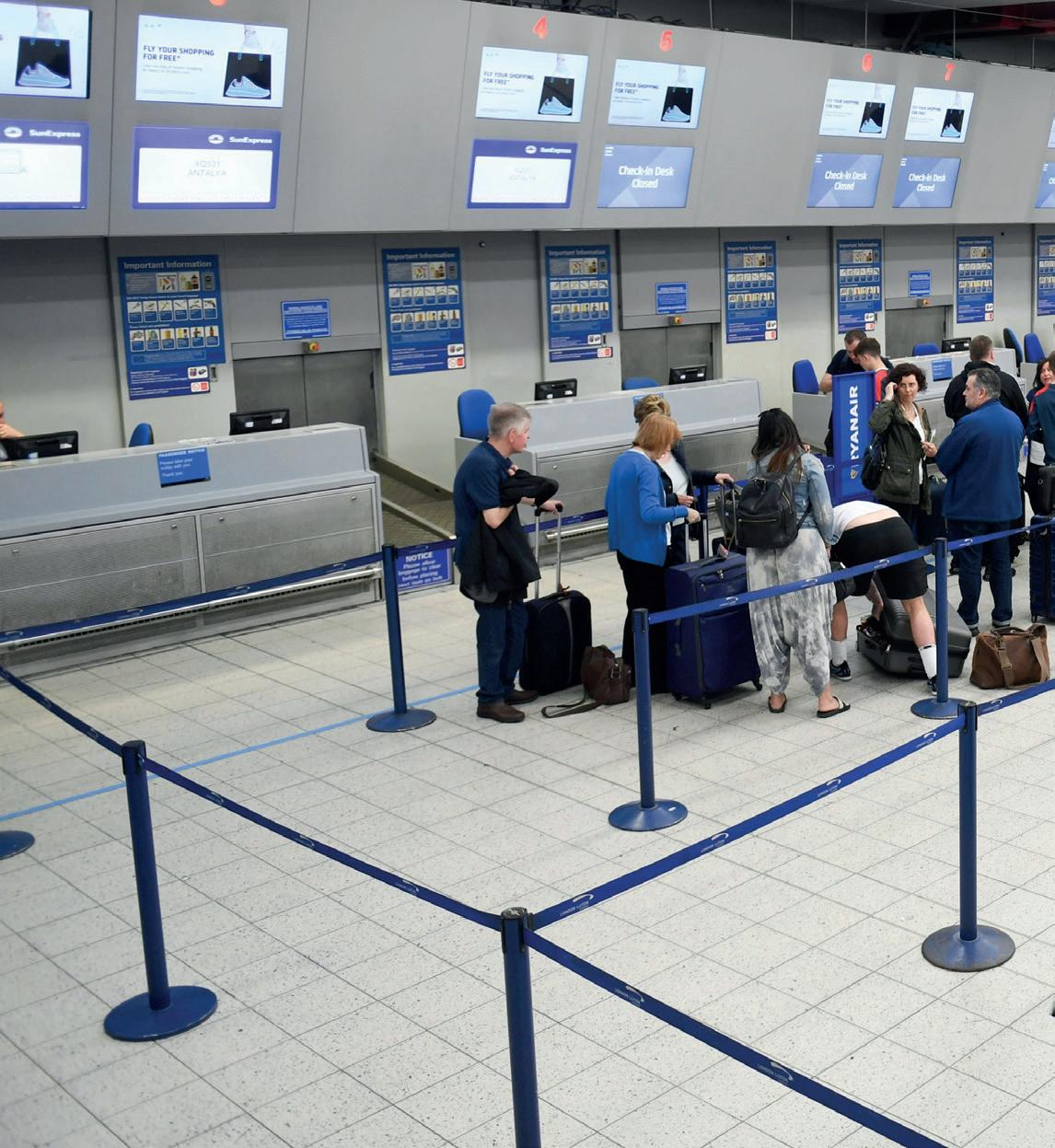
In addition, outdated tools present a risk of miscommunication or missed communication if airport staff or personnel from across the broader ecosystem are unable to access the information they need when they require it. Employees whose jobs are based away from desks can particularly struggle with a lack of information visibility if it can only be accessed from desktops and not mobile devices.
Rapid digital transformation in recent years means that passengers themselves have higher expectations when it comes to tech-facilitated experiences. Timely, accurate information, whether on flight information display screens (FIDS) or through mobile phone push notifications, is a minimum requirement. This is especially so when monitoring for changing flight information.
Overcoming stormy days
Technological trailblazers will be able to reap the benefits every day, but investing in technology proves itself to be particularly impactful when there are major disruptions that lie outside of airports’ control. Extreme weather events, which are becoming more prevalent due to global warming, are an example of this.
In the summer of 2021, many airports in the Florida region had to divert and cancel flights amid Tropical Storm Elsa, which brought heavy rain and flooding to the area.
Sarasota Bradenton International Airport (SRQ) was one of these airports, and with an average of 450 inbound flights to the airport each day, the weather presented what could have been an intense operational challenge as flight diversions and cancellations needed to be tracked and communicated internally and with passengers.
However, the airport had recently invested in cloud-based management software, which automatically received all scheduling changes as flights began to be cancelled in and out of SRQ. This made it easier to track the most recent updates and communicate this with passengers, which is one of the most challenging pre-storm issues faced by airports.
Commenting on the experience, Evan Knighting, the airport’s senior vice president and chief information officer, said: “Compared to last time something like this happened, communication was so much better, and we saved so much wasted time.
NEW TECHNOLOGY 40 AIRPORT WORLD/ISSUE 2, 2024

“People
didn’t need to chase down information, and we didn’t have passengers and tenants waiting around for any updates.”
Cloud-based data democratisation
Communication is key in responding to disruption and for smooth day-to-day operations, but there is an apparent misalignment between the scale of communication problems reported by airport leaders and awareness of how to overcome them.
Three in five acknowledge that failing to invest in technology will significantly hinder the airport’s future growth, but only three in 10 say that cloud-based operations management software could significantly improve operations. There is a limited number of proven cloud-based airport operations platforms on the market, which is potentially the reason for this knowledge gap.
Cloud-based platforms are the most effective way to create a single source of truth; fed by live data that can be accessed by all stakeholders, including baggage handlers, check-in desks, gate planners, FBOs, retail concessions, security staff and airlines.
Through such platforms, the airport workforce can access real-time information from any device, anywhere in the airport, receive instant updates such as flight statuses or long security queues and effectively communicate between themselves.
Monitoring passenger flow through a subset of AI, computer vision, for example, allows bottlenecks to be proactively solved and for passengers to pass through to concessions faster – and importantly, encourage spending.
This technology can utilise airports’ existing CCTV infrastructure to track passengers anonymously and intelligently, notifying personnel in real-time if dwell time exceeds their defined parameters, which could indicate issues at security, for example.
When combined with data analytics platforms, this data fuels predictive insights for better operational and commercial decision-making.
Immediate alerts to irregular operations and diversions are a game-changer for airport staff. Without a cloud-native operations platform, tenants and ground operators may only find out about scheduling changes when shown on FIDS boards, putting them on the

Centralised processes through cloud-based technologies offer a viable solution for airports that facilitate data sharing in real-time, with permissions that can extend as far as external contractors.
Acting as the ‘brain’ of the airport, cloud-native hubs store vital details of gate management, flight scheduling and more, and put this at the fingertips of employees, whoever or wherever they are. In addition, better decision-making processes using artificial intelligence (AI) and machine learning (ML) technology are supported through shared live dashboards.
With the agility and foresight offered by cloud-native management systems, airport leaders can co-ordinate teams to plan and adapt. They can ensure the right number of staff are stationed in the right place at the right time and subsequently boost passenger journeys while managing costs more effectively.
In conclusion
The modernisation of airport operations through cloud-based data democratisation offers a transformative solution to the persistent challenges experienced by many airports.
Airport leaders who leverage such innovation, rather than overlook the technology, will benefit from prompt, effective, data-driven responses to dynamic changes – be it flight delays, gate scheduling adjustments or unexpected disruptions such as extreme weather events.
Success stories from airports such as SRQ demonstrate how investing in advanced airport management systems that give all employees easy access to accurate, real-time data can mitigate operational challenges and boost resilience, as well as improve overall passenger experiences.
With ongoing challenges in air travel, such as aircraft shortages and prevalent flight delays and cancellations, airports must enter an era of rapid digital transformation to meet the growing expectations of passengers and stakeholders alike.
back foot when mitigating the impacts of changes and communicating with passengers.
NEW TECHNOLOGY 41 AIRPORT WORLD/ISSUE 2, 2024 AW

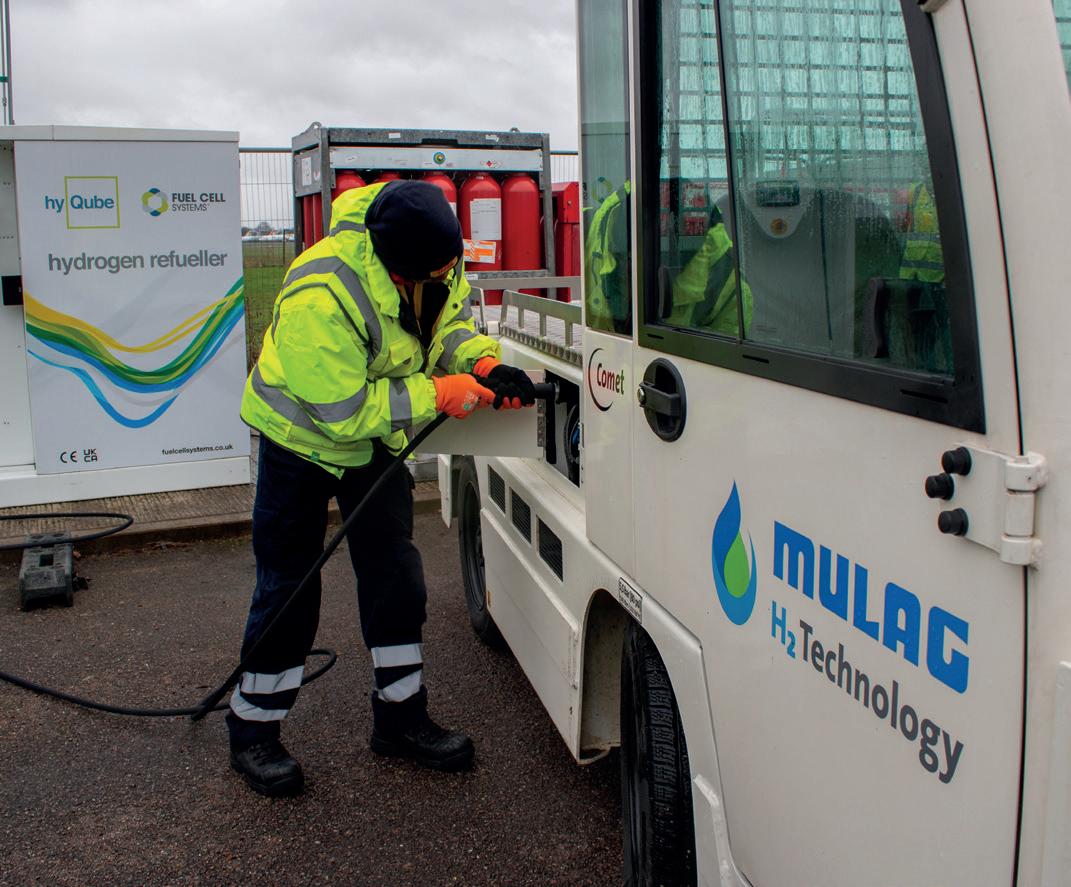
Green power
Airport World reports on a handful of new sustainability initiatives taking place at airports across Europe.
New green storage battery milestone for Copenhagen Airport Denmark's air gateway to the world, Copenhagen Airport (CPH), has installed a battery for storing green power.
The airport is a key partner in the EU-back ALRIGHT project that is designed to find smart solutions for the aviation sector based around the use of sustainable aviation fuels (SAF) and smart energy to help combat climate change.
CPH notes that going forward, it will be become crucial for airports to be able to store power from solar and wind energy to reduce emissions and achieve the goal of net-zero operations. Energy storage in batteries is part of the solution.
"We are pleased that we have succeeded in installing the battery in Copenhagen Airport. It is an important step towards more sustainable operations at the airport,” enthused CPH’s vice president of sustainability, Maria Skotte.
“Now we need to start testing different scenarios and find the best solution for energy storage at the airport, which we can then further develop on a larger scale in the airport.”
CPH is aware that the risks associated with operating a battery in an airport are numerous, but is confident that these have been mitigated through its collaboration with Danish Technological Institute, Hybrid Greentech and other partners in the ALIGHT project.
Hybrid Greentech is behind the energy management system that will be used to operate the battery at the airport. This also requires security measures.
The Danish hub believes that the smart management of its critical infrastructure is vital to support its green transformation, noting that Hybrid Greentech's management system will give it an overview of when it is most advantageous to store energy directly from the solar energy produced by the airport's many solar panels, and when it makes sense to charge the battery with green power from the grid.
"This is truly an exciting project we are engaged in. It will be a huge gain if we can manage to control the airport's energy consumption more smartly,” adds Skotte.
“This means not only reducing our electricity costs but, more importantly, reducing CO2 emission levels.”
Hydrogen refuelling trial at Bristol Airport
A ground-breaking airside hydrogen refuelling trial has been successfully completed at Bristol Airport.
The trial, led by easyJet and supported by several cross-industry partners, is the first of its kind at a regional UK airport.
Hydrogen was used to refuel and power ground support equipment (GSE) – specifically, baggage tractors – servicing easyJet passenger aircraft.
Conducted as part of the airline’s daily operations, the trial demonstrates that the gas can be safely and reliably used to refuel ground equipment in the busy, live airport environment.
The trial, dubbed Project Acorn, was in development for over a year and involved many other leading organisations from across aviation, engineering, logistics and academia.
These include Cranfield Aerospace Solutions, Cranfield University, Connected Places Catapult (CPC), DHL Supply Chain, Fuel Cell Systems, the IAAPS research institute, Jacobs, Mulag and TCR.
The group intends to use the outputs of the trial to help develop industry best practice standards and provide guidance to airports, airlines, local authorities and regulators on required infrastructure changes.
It also intends to support the development of a regulatory framework for hydrogen’s use on an airfield – standards which, due to hydrogen’s nascency in aviation, do not currently exist.
The data and insights gathered will also feed into research that groups like Hydrogen in Aviation (HIA) are conducting to ensure UK infrastructure, regulatory and policy changes keep pace with the technological developments in carbon-emission free flying.
UK Aviation Minister, Anthony Browne, enthuses: “Innovative projects like this are crucial to achieving our target set out in the Jet Zero Strategy of achieving zero emission airport operations by 2040.”
Vegetable powered vehicles cut Gatwick’s CO2 emissions London Gatwick says that it has cut carbon emissions from its diesel vehicles by 90% by swapping the fuel for Hydrotreated Vegetable Oil (HVO). The switch means London Gatwick will save more than 950 tonnes of carbon emissions per annum.
42 AIRPORT WORLD/ISSUE 2, 2024
SUSTAINABILITY NEWS
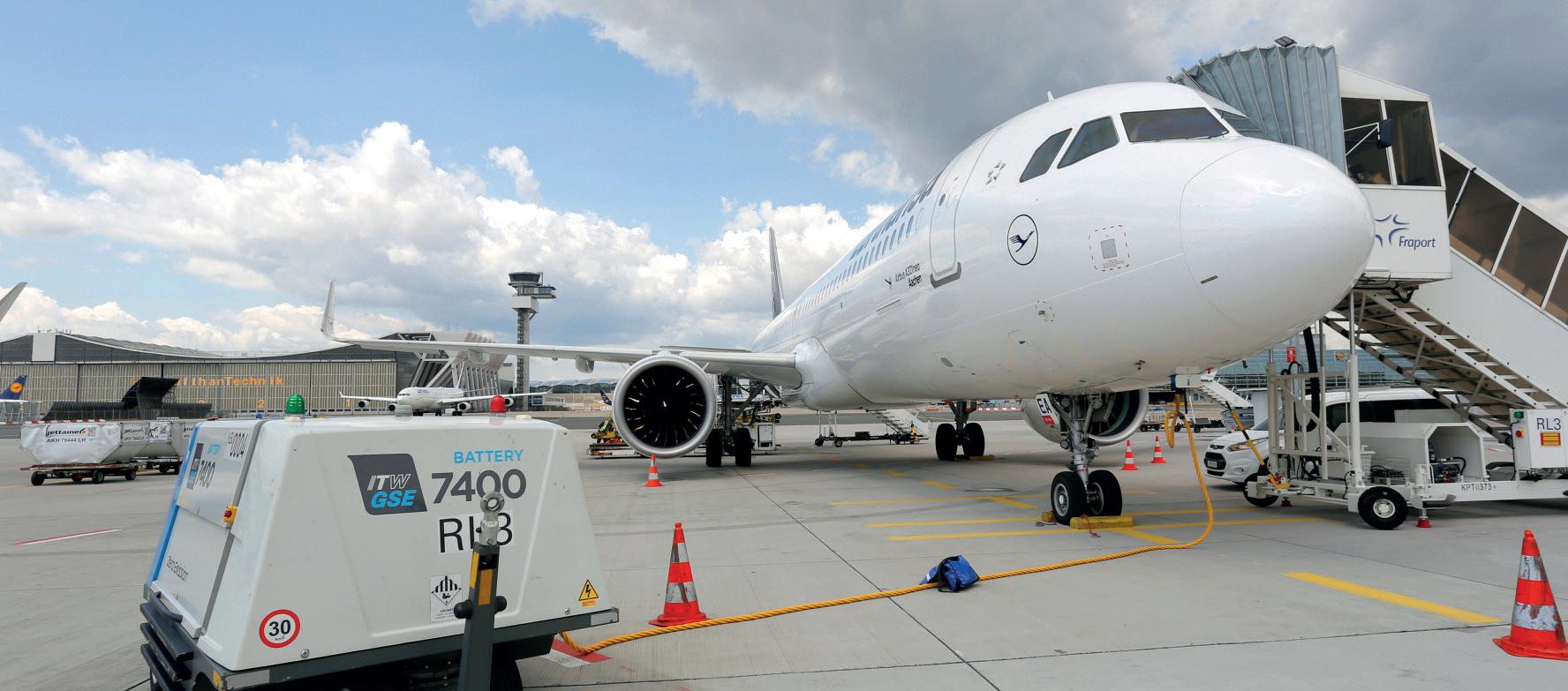
HVO is a low-carbon biofuel made from plant waste, oils and fats making it a more sustainable and lower-carbon alternative to diesel.
All 300 diesel vehicles, 85% of London Gatwick’s fleet, are now powered by HVO until they are retired from use. They will then be replaced by electric vehicles as part of the airport’s sustainability policy, Decade of Change.
Some of the vehicles now powered by HVO include all the airport’s fire engines, airside operations vehicles and snow ploughs.
An extensive trial concluded that HVO had no impact on the performance of the vehicles, meaning the fire engines still have the capability to respond to call outs anywhere on the airfield within three minutes.
The UK gateway’s head of engineering, Steve Kelso, said: “The implementation of Hydrotreated Vegetable Oil to power our 300 diesel vehicles is an exciting milestone for London Gatwick’s sustainability journey and a big step in our fleet transition.
“It is vital we invest in sustainably sourced HVO to reduce emissions in all areas as soon as possible on our journey to reach net zero for our own Scope 1 and 2 emissions by 2030.
“From the buses that pick passengers up from the long-stay car parks, to operations vehicles that patrol the airfield, HVO is now being used to fuel vehicles throughout the airport. As we continue to grow, we are making sustainability part of everything we do here at London Gatwick and we are committed to finding solutions and working differently to meet our ambitious targets.”
Timeline set for phasing out diesel ground power units at FRA
As part of its global climate protection strategy, airport operator, Fraport, has announced its commitment to phasing out the remaining diesel powered units supplying electricity to aircraft parked at Frankfurt Airport by 2040.
However, the nature of the airport’s infrastructure means that it will not be possible to equip each one of the current 255 aircraft positions with a stationary 400Hz connection. At these remaining aircraft parking positions, only battery-powered ground power units (GPUs) will be used.
The initiative has been boosted by €215,000 in funding from the German government.
Fraport AG project manager for central infrastructure airside, Christoph Schiller, says: “The first aim is to connect those parking positions that do not yet have a stationary ground power connection to
the electric grid. But to achieve this, major excavation works are necessary. These need to take place during ongoing operations. We are therefore proceeding on the basis that we will be able to upgrade around 12 positions by 2026.
“Going forward, we will need mobile e-GPUs at some positions. With every diesel unit that we remove from the apron, we can save up to 30,000 litres of diesel annually and significantly reduce our CO2 emissions.”
The airport operator currently has eight e-GPUs and around 61 diesel- powered units in use at Frankfurt Airport.
Fraport notes that climate protection a key component of its sustainability strategy. It has pledged to reduce carbon emissions at Frankfurt Airport to 50,000 tonnes annually by 2030 before it and all the other airports in its network operate on a carbon-free basis by 2045 at the latest.
Innovative waste recycling solution for Birmingham Airport Birmingham Airport (BHX) has appointed a new waste contractor, Bidvest Noonan, who working in partnership with The Green Block, has installed a Mobile Segregation Unit (MSU) at the airport.
The unit, which enables the separating, washing, compacting, baling, weighing, and electronic tagging of waste, through highly efficient sortation and segregation processes, will allow BHX to achieve higher recycling rates.
The MSU also reduces contamination of recyclable materials, and since being installed, has prevented 264 tonnes of waste from becoming non-recyclable general waste.
In addition, the MSU will provide data insights into the breakdown of waste for individual on-site partners and specific areas, to allow targeted improvements across the airport.
BHX is the first airport worldwide to implement an MSU solution in partnership with The Green Block and has a commitment to reach recycling rates of 65%, as outlined in its sustainability strategy.
Tom Denton, head of sustainability at Birmingham Airport, said: “Birmingham Airport is committed to improving recycling rates, focusing primarily on reducing and re-using waste, then recycling wherever possible. Our Sustainability Strategy sets out our waste, supply chain and circular economy commitments, and we are always determined to find innovative ways to reduce our environmental impact.”
43 AIRPORT WORLD/ISSUE 2, 2024
SUSTAINABILITY NEWS AW
Open for business
We round-up some of the latest ACI World Business Partner stories from across the globe.

New terminals to transform travel to Mobile and Monterey
Global design, architecture, engineering and planning firm, HOK, has unveiled new five-gate terminal designs for Mobile and Monterey airports, which are expected to transform travel and provide an intuitive and elevated experience for passengers at both US gateways.
In Monterey, HOK says that the new terminal will replace the current outdated facility, noting that the single-level layout promotes accessibility and easy wayfinding.
An apron level below will support airport, airline and maintenance staff. The project will include the airport’s first passenger boarding bridges so travellers can easily access planes in any weather.
New Travelex stores open in new Abu Dhabi terminal
Travelex, the global travel money brand, has launched seven stores and eight ATMs in the new Terminal A at Abu Dhabi’s Zayed International Airport.
The four landside and three airside stores take the total number of Travelex stores in the UAE to 49 following expansion at Abu Dhabi, Dubai and Sharjah Airports in recent months.
In addition, Travelex is investing in the refurbishment and expansion of its existing stores at Sharjah airport.
Batu Dolay, the company’s commercial director for the Middle East and Turkey, said: “Zayed International Airport’s Terminal A sets a new benchmark for a modern, seamless airport experience, tying in perfectly with our mission to simplify our customers’ access to international money.
“We are, therefore, delighted to have launched seven new stores and eight ATMs across the new terminal, affording travellers flying to and from Abu Dhabi more convenience in their international money transactions than ever before.”
According to HOK, the nature-inspired design features a presecurity garden plaza with lush, native landscaping. From the garden, a glass wall offers views into the terminal’s post-security central plaza, which features a centre bar for dining and various seating options for rest and relaxation.
A post-security outdoor terrace showcases the region’s scenic beauty and mild climate.
“The Monterey Peninsula Airport District sought a beautiful and cost-effective design that expresses the beauty of Monterey,” said Bart van Vliet, project manager in HOK’s San Francisco studio.
“We’re collaborating with them to create an innovative terminal that wows and welcomes passengers to Monterey.”

RUNNING HEAD 44
AIRPORT WORLD/ISSUE 2, 2024
WBP NEWS

New Heinemann store unveiled at Gold Coast Airport
Heinemann Oceania has officially opened the doors to its new store in Gold Coast Airport’s domestic terminal.
A first for the domestic terminal, and as part of ongoing upgrades to the precinct, the store is said to “a world-class luxury shopping experience to Gold Coast domestic travellers”.
Featuring iconic brands such Tom Ford, Jo Malone, Clinique, Gucci, Dior, Yves Saint Laurent and Versace, the range mirrors Heinemann’s offering in its international equivalent, spoiling beauty enthusiasts for choice regardless of whether they are flying domestically or internationally.
As part of its service, Heinemann now offers home delivery nationwide, which means passengers can confidently shop without worrying about carrying their purchases with them in-flight and onto their next destination. This is in addition to Heinemann’s established Click & Collect and Shop and Collect services.
“We are delighted to bring the best that Heinemann has to offer to domestic travellers as well as international duty-free,” noted Heinemann Oceania's managing director, George Tsoukalas.
“We are all about the customer journey and we are excited that we can now serve passengers whether they are travelling domestically, internationally or transiting.”
Woolpert aquires Murphy Geospatial
Woolpert has acquired Murphy Geospatial, a multi-disciplinary geospatial solutions company that is headquartered in Kilcullen, Ireland.
Woolpert is a private, US-based architecture, engineering, and geospatial firm that was founded in 1911 and has been providing comprehensive and integrated geospatial services for more than 50 years.
Woolpert notes that the acquisition will enable the companies to align best practices, leverage
operational efficiencies, and advance services that include survey, reality capture, BIM, asset monitoring, GIS, and all forms of mapping.
Neil Churman, president of Woolpert, enthused: “Together with Murphy Geospatial, Woolpert will expand its geospatial presence in Europe to improve our offering to customers, accelerate next-level solutions, and provide vital support to the infrastructure, manufacturing, construction, property, utility, and natural environment sectors.”
New passenger screening contract for Rapiscan
Rapiscan, an OSI Systems company, has announced that it has received a $5 million order to provide its 920CT baggage screening technology at the security checkpoint at leading international airport in Europe.
Deepak Chopra, OSI Systems' chairman and CEO, said: "We are pleased with this award and
look forward to supporting the customer’s efforts to upgrade its security infrastructure.
“We strive to elevate passenger screening processes with advanced CT checkpoint technology for an enhanced and efficient airport experience."
ADECS AIRINFRA
Membership Region: Europe
Type of Business: IT & Communications
W: www.airinfra.eu
Adecs Airinfra offers consultancy and IT solutions to support airports with their development and improve airport efficiency. Its areas of activity are airport strategic planning; airport operations management; environment and spatial planning; airport sustainability; and air traffic management. Adecs Airinfra has 10 years of experience in these areas of activity.
TRANSOFT SOLUTIONS
Membership Region: North America
Type of Business: IT & Communications
W: www.transoftsolutions.com
Transoft Solutions provides innovative CAD-based software for the international engineering and architectural community.
Transoft's AeroTURN Pro is an advanced gate design and aircraft manoeuvring simulation software developed for airport planners, designers, and engineers. Transoft's ParkCAD software is used for the efficient generation and testing of parking facilities.
VINO VOLO
Membership Region: North America
Type of Business: Retail & Commercial
W: www.vinovolo.com
Vino Volo aims to revolutionise how people experience wine. Vino Volo (derived from ‘wine flight’ in Italian) offers a selection of local, regional, and international wines by the glass, in tasting flights, and by the bottle for guests to take home or have shipped.
Vino Volo states that it has taken airport service to a new level.
AW
RUNNING HEAD 45 AIRPORT WORLD/ISSUE 2, 2024 WBP NEWS 45
PEOPLE matters
The design of work
Richard Plenty and Terri Morrissey reflect on the importance of paying attention to designing a people-centric working environment.
As we write this article, we have just completed running the April 2024 ACI Human Resources programme, a five-day course which educates airport leaders and future leaders on key concepts and frameworks in modern strategic human resources management.
The course aims to develop the mindset, knowledge and skills necessary to lead and get the best from people in an airport context and achieve sustainable high performance in a world of uncertainty and change.
The course objectives and content are very topical. People aspects of the business are currently at the top of the agenda as airports face the challenges of attracting, recruiting and retaining sufficient numbers of skilled people to cope with the increased demand for travel.
We discuss how airports are changing and the skills required for the future. We work with participants to consider how their airports can become more attractive as employers, particularly to younger people. We also spend time looking at how best to engage and motivate people, so they want to stay working in the organisation.
One conclusion that emerges from just about every course is the importance of paying more attention to the design of work. This means designing and crafting work environments which enhance and encourage high performance and work enjoyment.
Most people intuitively understand that poor work design can inhibit workplace creativity, enjoyment and performance. How many people perform well when they don’t understand what is going on? How many of us enjoy being ‘micromanaged’ and not given a certain amount of autonomy in how we execute our role?
So, it is important that airport leaders establish organisation and work design principles that can help create a great working
environment – a sustainable, high-performance culture which fosters employee engagement and helps people to thrive and grow. The following practices provide a starting point:
• Communicate a clear and inspiring organisation vison, mission and values so that people have the opportunity to understand and buy into the organisation’s purpose and direction – and feel a sense of ‘belonging’.
• Ensure the structure of the organisation facilitates the delivery of objectives, with clear role accountabilities and responsibilities. People need to understand what’s expected of them and should have a degree of autonomy in how they go about it.
• Design systems and processes that make it easier for people to do their work, including digital and IT which help get the job done, and where there is some flexibility in working arrangements
• Develop a culture where high performance is expected and recognised, where people are supported, appreciated and treated with respect, and where there are opportunities for personal growth and career development. The style of leadership makes a huge difference to the working environment. Leaders at all levels need to role model the behaviours they would like to see.
There are many practical ways of putting these principles into practice. A recent publication from ACI EUROPE’s Leadership & HR Forum, People Engagement Guide 2023 provides hints and tips on those which are particularly important for work motivation. Creating a top performing airport is about people as well as technology. Investing time and resources in designing a people-centric work environment is as important as designing the physical infrastructure. It’s two journeys – not one.
Jim Szczesniak is the new the director of aviation for the City of Houston and will oversee the management and operations of George Bush Intercontinental Airport (IAH), William P Hobby Airport (HOU), Ellington Airport (EFD) and the Houston Spaceport. Szczesniak brings a wealth of experience having previously served as the airport director for the Ted Stevens Anchorage International Airport and he spent a decade at the Chicago Department of Aviation where he eventually became deputy commissioner of aviation for O’Hare and Midway airports.
Elsewhere in Texas, Austin-Bergtstrom International Airport has named Ghizlane Badawi as its new chief executive officer, ending a year-long period of temporary leadership after the sudden resignation of the previous CEO last spring. The appointment of Badawi, who had been serving as interim CEO, is designed to "bring stability" to Austin-Bergstrom ahead of a host of expansion-related decisions before the City Council later this year.
Los Angeles World Airports (LAWA) CEO, John Akerman, has made three new additions to his executve leadership team, appointing Maria Bleavins as chief airport administrative officer, Robert Lowe as chief people and culture officer, and Becca Doten as chief of staff.
London Gatwick has a new chief operating officer, Mark Johnston. He joins from AGS Airports, the owners of Aberdeen, Glasgow and Southampton airports in the UK, where he held a similar role for more than three years.
About the authors
Terri Morrissey and Dr Richard Plenty run ACI’s Human Resources training. They received a Presidential Citation from the American Psychological Association in June 2022 for their leadership in advancing global psychology. Contact them at info@thisis.eu
46 AIRPORT WORLD/ISSUE 2, 2024 AW HUMAN RESOURCES
23-25 September 2024 | Amsterdam, The Netherlands


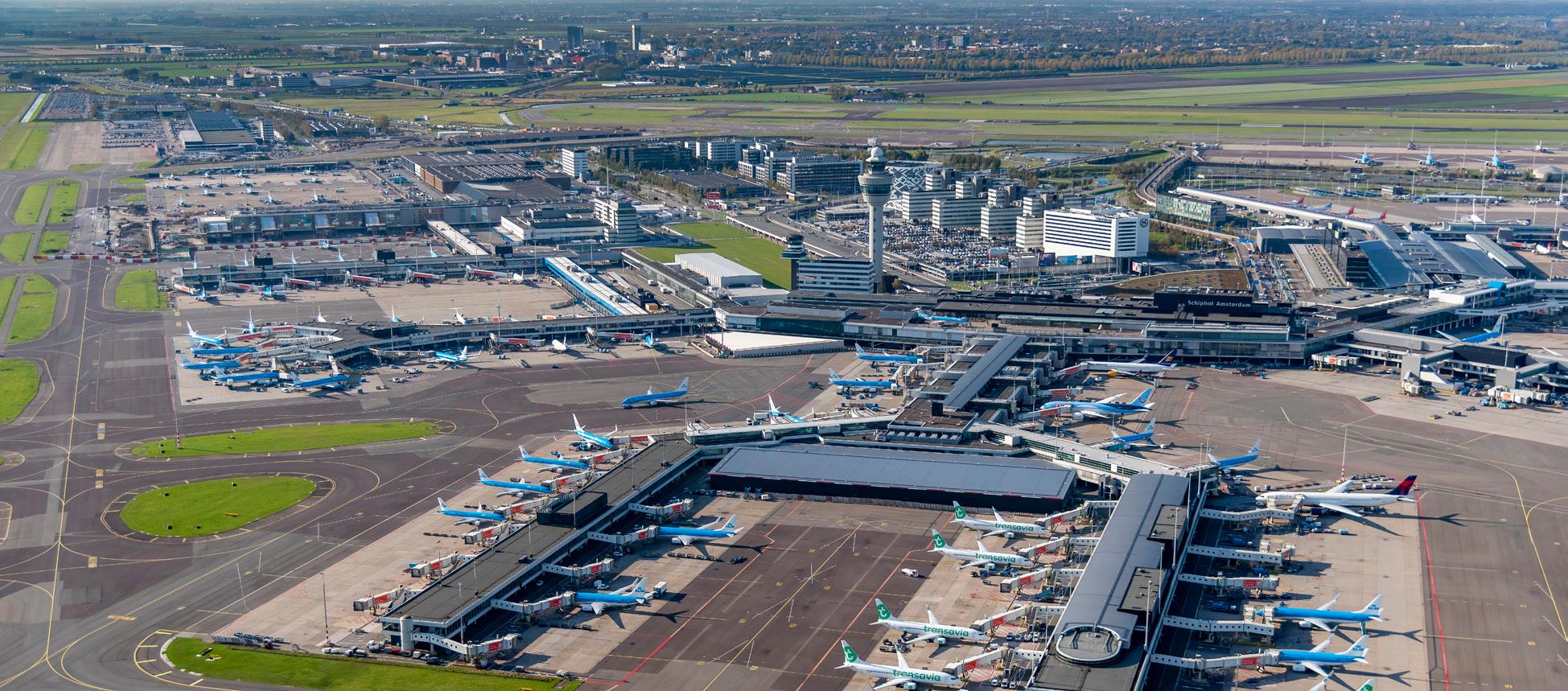
Find out more on smart-airports.com/europe
SMART Airports & Regions Europe 2024 Conference & Exhibition
Hosted by
Evening Networking Party
Hosted by

Power Your Digital Twin with Esri
Airports are leveraging digital twins to gain a comprehensive view of their facilities, to improve operations and security, and to deliver a better passenger experience.
With Esri’s geographic information system (GIS) technology, you can create a digital twin to enhance asset control signaling and monitoring (ACSM), derive passenger flow information, and move assets on the runway—all to help optimize airport operations.
Discover how GIS is foundational to your airport’s digital twin.
To learn more, go to go.esri.com/esri-airport-digital-twins.
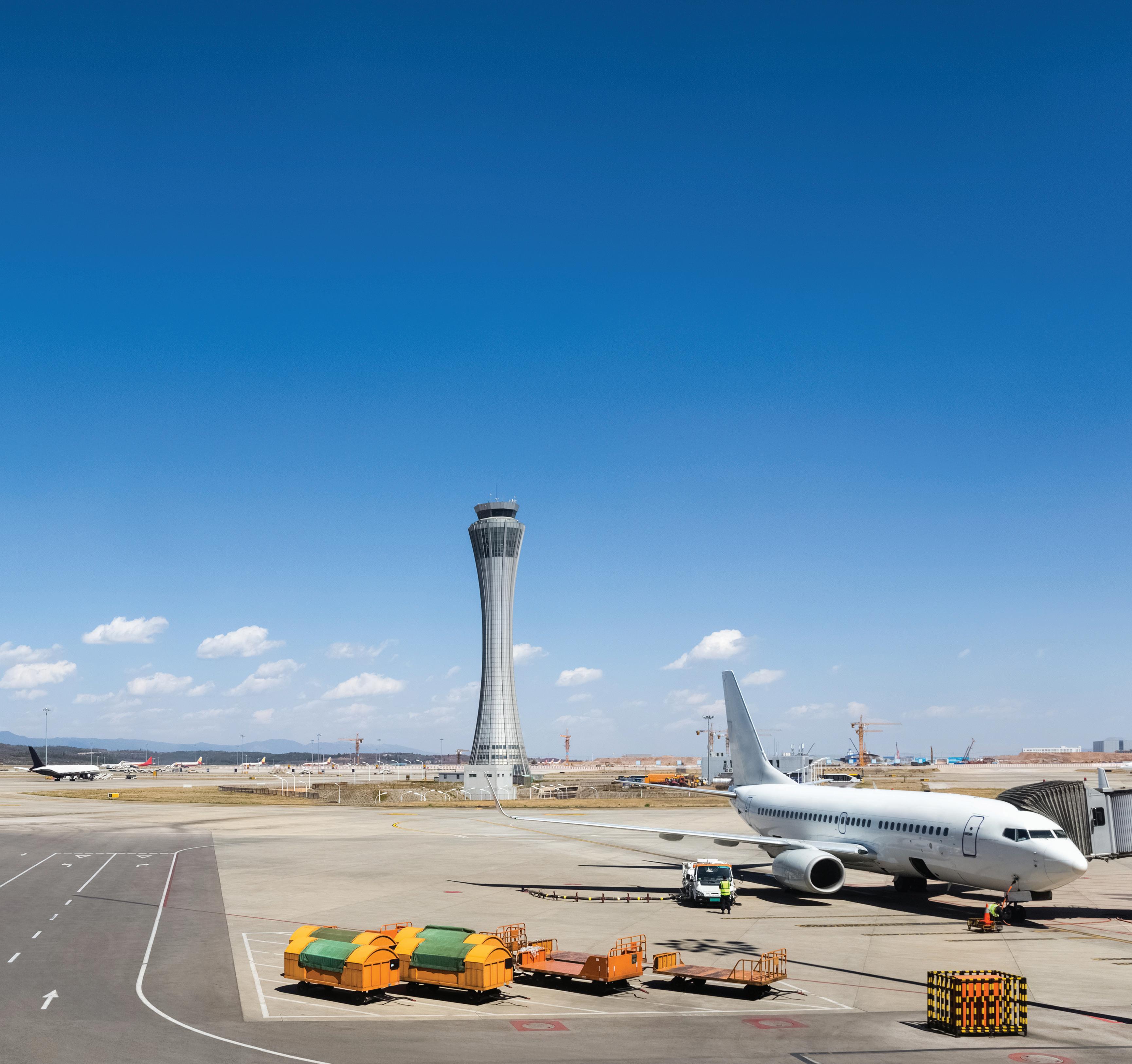



























 Hosted by
Hosted by






































































 and design at Nashville Airport
and design at Nashville Airport















































